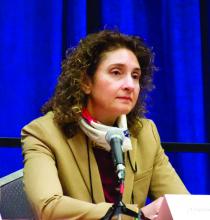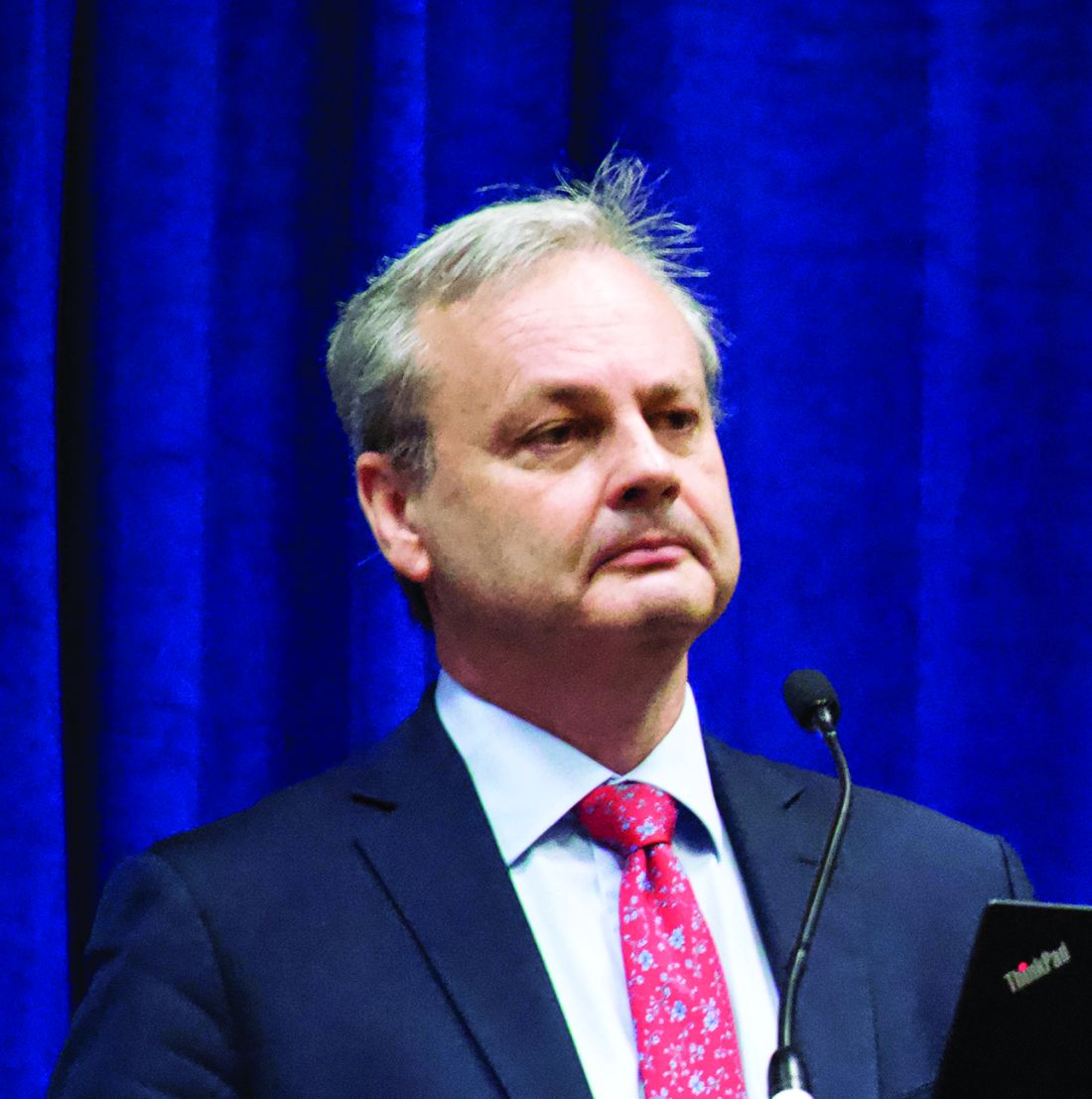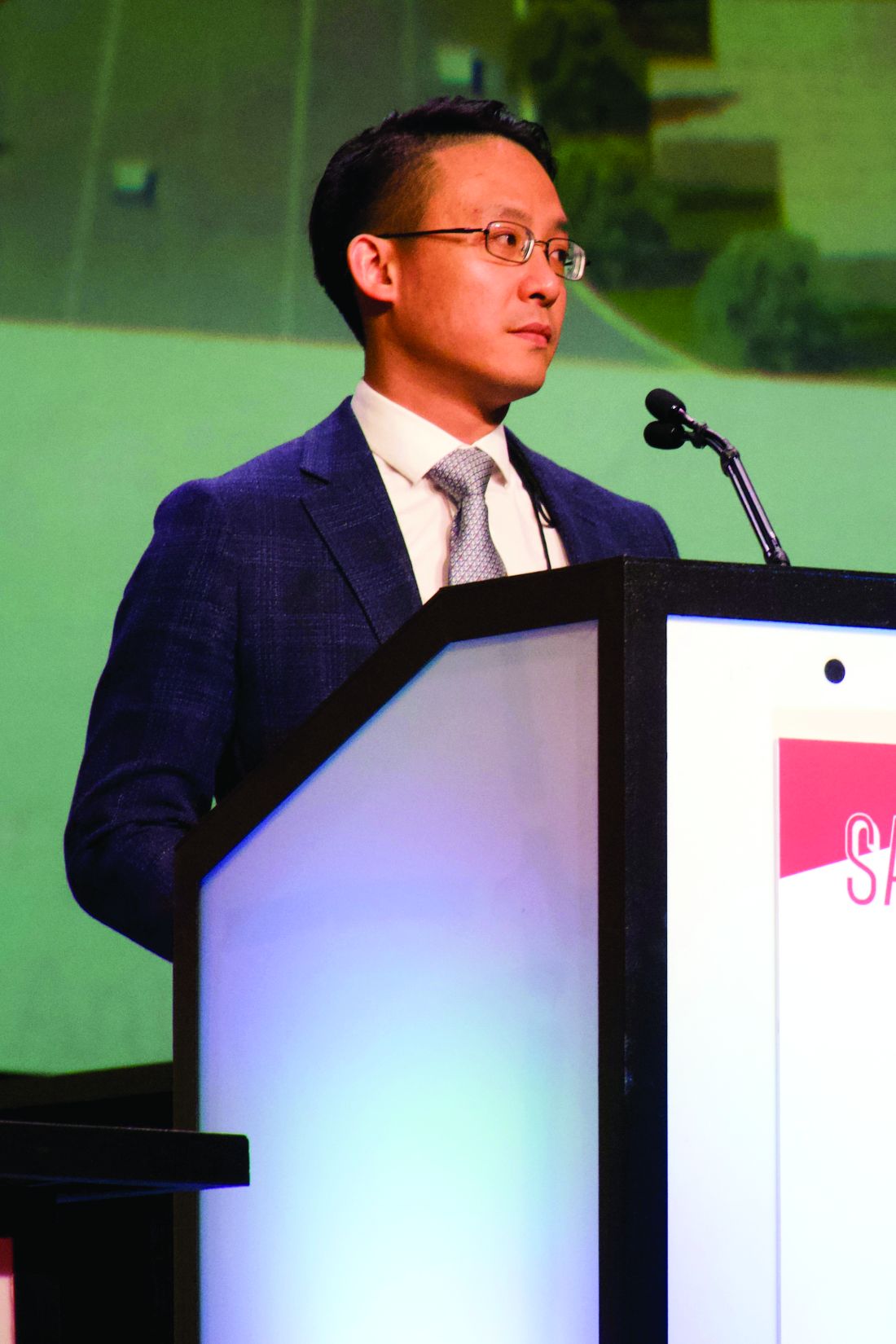User login
ctDNA shows clinical value in advanced breast cancer
SAN ANTONIO – The high accuracy and efficiency of circulating tumor DNA (ctDNA) testing allows for routine clinical use in advanced breast cancer, according to investigators.
The plasmaMATCH trial showed that gene level agreement between ctDNA results measured by digital PCR versus sequencing was as high as 99.4%, reported lead author Nicholas Turner, MA, MRCP, PhD, of The Institute of Cancer Research and The Royal Marsden NHS Foundation Trust, London.
Dr. Turner, who presented findings at the San Antonio Breast Cancer Symposium, said that ctDNA testing can detect rare mutations and link patients with targeted therapies that have clinically relevant response rates.
“Multiple somatic mutations are potentially targetable in the treatment of advanced breast cancer,” Dr. Turner said. “In addition, mutations may be acquired [during treatment].”
The diverse and dynamic landscape of mutations in breast cancer creates a need to genotype tumors without repeating biopsies, Dr. Turner said. He noted that ctDNA is one possible means of fulfilling this need, although more prospective research is required to determine clinical utility.
To this end, the investigators conducted the phase II plasmaMATCH trial, a multiple parallel cohort, multicenter study involving 1,044 patients with advanced breast cancer. All patients had ctDNA testing performed prospectively with digital droplet PCR (ddPCR); in addition, ctDNA testing was performed with error-corrected sequencing using Guardant360, either prospectively or retrospectively. If actionable mutations were identified, and consent was provided, then patients entered the treatment cohort, which was composed of 142 participants.
Patients were divided into four parallel treatment cohorts based on ctDNA mutation results and accompanying treatments, as follows:
- (A) ESR1 mutation; extended-dose fulvestrant.
- (B) HER2 mutation; neratinib with or without fulvestrant.
- (C) AKT1 in estrogen receptor–positive disease; capivasertib plus fulvestrant.
- (D) “AKT basket” – AKT1 in estrogen receptor–negative disease or PTEN inactivating mutation; capivasertib.
The primary objective was response rate. For cohort A, at least 13 out of 78 evaluable patients (17%) needed to have a response to infer sufficient efficacy of the matched therapy. For the remaining cohorts, sufficient efficacy was defined by responses in at least 3 out of 16 evaluable patients (19%).
Secondary objectives included frequency of targetable mutations, accuracy of ctDNA testing (to be reported later), and others.
Results showed that ESR1 mutations were most common within the original population (27.7%), followed by AKT1 mutations (4.2%) and HER2 mutations (2.7%). In the treatment cohort, more than half of the patients had a HER2 mutation (58%) and/or an AKT1 mutation (54%), whereas a smaller proportion had an ESR1 mutation (38%). Approximately two-thirds of patients (64%) had hormone receptor–positive, HER2-negative breast cancer; 17% had triple-negative breast cancer; 6% had hormone receptor–positive, HER2-positive disease; 3% had hormone receptor–negative, HER2-positive disease; and 9% had other/unknown phenotypes. Approximately two-thirds of patients (65%) had received at least two lines of prior therapy for advanced disease.
For patients with an ESR1 mutation treated with extended-dose fulvestrant (cohort A) only 8.1% achieved a response, which was below the threshold for inferred efficacy. For patients with a HER2 mutation treated with neratinib with or without fulvestrant (cohort B), 25.0% had a response, thereby demonstrating inferred efficacy. Efficacy was also inferred in patients with an AKT1 mutation treated with capivasertib plus fulvestrant (cohort C), as 22.2% of these patients had a response. In the AKT basket (cohort D), 10.5% of patients had a response, which fell below the efficacy threshold; however, an exploratory analysis of this cohort showed that patients with an AKT1 mutation had a response rate of 33.3% (two out of six patients), which did meet efficacy criteria.
Adverse events were consistent with previous reports. The investigators noted that extended-dose fulvestrant was well tolerated.
“In conclusion, we show that circulating tumor DNA testing offers a simple, efficient and relatively fast method of tumor genotyping,” Dr. Turner said.
The investigators disclosed relationships with Puma Biotechnology, AstraZeneca, Guardant Health, and Bio-Rad.
SOURCE: Turner et al. SABCS. 2019 Dec 12. Abstract GS3-06.
SAN ANTONIO – The high accuracy and efficiency of circulating tumor DNA (ctDNA) testing allows for routine clinical use in advanced breast cancer, according to investigators.
The plasmaMATCH trial showed that gene level agreement between ctDNA results measured by digital PCR versus sequencing was as high as 99.4%, reported lead author Nicholas Turner, MA, MRCP, PhD, of The Institute of Cancer Research and The Royal Marsden NHS Foundation Trust, London.
Dr. Turner, who presented findings at the San Antonio Breast Cancer Symposium, said that ctDNA testing can detect rare mutations and link patients with targeted therapies that have clinically relevant response rates.
“Multiple somatic mutations are potentially targetable in the treatment of advanced breast cancer,” Dr. Turner said. “In addition, mutations may be acquired [during treatment].”
The diverse and dynamic landscape of mutations in breast cancer creates a need to genotype tumors without repeating biopsies, Dr. Turner said. He noted that ctDNA is one possible means of fulfilling this need, although more prospective research is required to determine clinical utility.
To this end, the investigators conducted the phase II plasmaMATCH trial, a multiple parallel cohort, multicenter study involving 1,044 patients with advanced breast cancer. All patients had ctDNA testing performed prospectively with digital droplet PCR (ddPCR); in addition, ctDNA testing was performed with error-corrected sequencing using Guardant360, either prospectively or retrospectively. If actionable mutations were identified, and consent was provided, then patients entered the treatment cohort, which was composed of 142 participants.
Patients were divided into four parallel treatment cohorts based on ctDNA mutation results and accompanying treatments, as follows:
- (A) ESR1 mutation; extended-dose fulvestrant.
- (B) HER2 mutation; neratinib with or without fulvestrant.
- (C) AKT1 in estrogen receptor–positive disease; capivasertib plus fulvestrant.
- (D) “AKT basket” – AKT1 in estrogen receptor–negative disease or PTEN inactivating mutation; capivasertib.
The primary objective was response rate. For cohort A, at least 13 out of 78 evaluable patients (17%) needed to have a response to infer sufficient efficacy of the matched therapy. For the remaining cohorts, sufficient efficacy was defined by responses in at least 3 out of 16 evaluable patients (19%).
Secondary objectives included frequency of targetable mutations, accuracy of ctDNA testing (to be reported later), and others.
Results showed that ESR1 mutations were most common within the original population (27.7%), followed by AKT1 mutations (4.2%) and HER2 mutations (2.7%). In the treatment cohort, more than half of the patients had a HER2 mutation (58%) and/or an AKT1 mutation (54%), whereas a smaller proportion had an ESR1 mutation (38%). Approximately two-thirds of patients (64%) had hormone receptor–positive, HER2-negative breast cancer; 17% had triple-negative breast cancer; 6% had hormone receptor–positive, HER2-positive disease; 3% had hormone receptor–negative, HER2-positive disease; and 9% had other/unknown phenotypes. Approximately two-thirds of patients (65%) had received at least two lines of prior therapy for advanced disease.
For patients with an ESR1 mutation treated with extended-dose fulvestrant (cohort A) only 8.1% achieved a response, which was below the threshold for inferred efficacy. For patients with a HER2 mutation treated with neratinib with or without fulvestrant (cohort B), 25.0% had a response, thereby demonstrating inferred efficacy. Efficacy was also inferred in patients with an AKT1 mutation treated with capivasertib plus fulvestrant (cohort C), as 22.2% of these patients had a response. In the AKT basket (cohort D), 10.5% of patients had a response, which fell below the efficacy threshold; however, an exploratory analysis of this cohort showed that patients with an AKT1 mutation had a response rate of 33.3% (two out of six patients), which did meet efficacy criteria.
Adverse events were consistent with previous reports. The investigators noted that extended-dose fulvestrant was well tolerated.
“In conclusion, we show that circulating tumor DNA testing offers a simple, efficient and relatively fast method of tumor genotyping,” Dr. Turner said.
The investigators disclosed relationships with Puma Biotechnology, AstraZeneca, Guardant Health, and Bio-Rad.
SOURCE: Turner et al. SABCS. 2019 Dec 12. Abstract GS3-06.
SAN ANTONIO – The high accuracy and efficiency of circulating tumor DNA (ctDNA) testing allows for routine clinical use in advanced breast cancer, according to investigators.
The plasmaMATCH trial showed that gene level agreement between ctDNA results measured by digital PCR versus sequencing was as high as 99.4%, reported lead author Nicholas Turner, MA, MRCP, PhD, of The Institute of Cancer Research and The Royal Marsden NHS Foundation Trust, London.
Dr. Turner, who presented findings at the San Antonio Breast Cancer Symposium, said that ctDNA testing can detect rare mutations and link patients with targeted therapies that have clinically relevant response rates.
“Multiple somatic mutations are potentially targetable in the treatment of advanced breast cancer,” Dr. Turner said. “In addition, mutations may be acquired [during treatment].”
The diverse and dynamic landscape of mutations in breast cancer creates a need to genotype tumors without repeating biopsies, Dr. Turner said. He noted that ctDNA is one possible means of fulfilling this need, although more prospective research is required to determine clinical utility.
To this end, the investigators conducted the phase II plasmaMATCH trial, a multiple parallel cohort, multicenter study involving 1,044 patients with advanced breast cancer. All patients had ctDNA testing performed prospectively with digital droplet PCR (ddPCR); in addition, ctDNA testing was performed with error-corrected sequencing using Guardant360, either prospectively or retrospectively. If actionable mutations were identified, and consent was provided, then patients entered the treatment cohort, which was composed of 142 participants.
Patients were divided into four parallel treatment cohorts based on ctDNA mutation results and accompanying treatments, as follows:
- (A) ESR1 mutation; extended-dose fulvestrant.
- (B) HER2 mutation; neratinib with or without fulvestrant.
- (C) AKT1 in estrogen receptor–positive disease; capivasertib plus fulvestrant.
- (D) “AKT basket” – AKT1 in estrogen receptor–negative disease or PTEN inactivating mutation; capivasertib.
The primary objective was response rate. For cohort A, at least 13 out of 78 evaluable patients (17%) needed to have a response to infer sufficient efficacy of the matched therapy. For the remaining cohorts, sufficient efficacy was defined by responses in at least 3 out of 16 evaluable patients (19%).
Secondary objectives included frequency of targetable mutations, accuracy of ctDNA testing (to be reported later), and others.
Results showed that ESR1 mutations were most common within the original population (27.7%), followed by AKT1 mutations (4.2%) and HER2 mutations (2.7%). In the treatment cohort, more than half of the patients had a HER2 mutation (58%) and/or an AKT1 mutation (54%), whereas a smaller proportion had an ESR1 mutation (38%). Approximately two-thirds of patients (64%) had hormone receptor–positive, HER2-negative breast cancer; 17% had triple-negative breast cancer; 6% had hormone receptor–positive, HER2-positive disease; 3% had hormone receptor–negative, HER2-positive disease; and 9% had other/unknown phenotypes. Approximately two-thirds of patients (65%) had received at least two lines of prior therapy for advanced disease.
For patients with an ESR1 mutation treated with extended-dose fulvestrant (cohort A) only 8.1% achieved a response, which was below the threshold for inferred efficacy. For patients with a HER2 mutation treated with neratinib with or without fulvestrant (cohort B), 25.0% had a response, thereby demonstrating inferred efficacy. Efficacy was also inferred in patients with an AKT1 mutation treated with capivasertib plus fulvestrant (cohort C), as 22.2% of these patients had a response. In the AKT basket (cohort D), 10.5% of patients had a response, which fell below the efficacy threshold; however, an exploratory analysis of this cohort showed that patients with an AKT1 mutation had a response rate of 33.3% (two out of six patients), which did meet efficacy criteria.
Adverse events were consistent with previous reports. The investigators noted that extended-dose fulvestrant was well tolerated.
“In conclusion, we show that circulating tumor DNA testing offers a simple, efficient and relatively fast method of tumor genotyping,” Dr. Turner said.
The investigators disclosed relationships with Puma Biotechnology, AstraZeneca, Guardant Health, and Bio-Rad.
SOURCE: Turner et al. SABCS. 2019 Dec 12. Abstract GS3-06.
REPORTING FROM SABCS 2019
Sensitivity of ctDNA equivalent to that of tumor tissue sequencing
SAN ANTONIO – For detection of genomic aberrations in patients with advanced breast cancer, sensitivity of circulating tumor DNA (ctDNA) testing is effectively equivalent to that of tumor tissue sequencing, based on results of the plasmaMATCH trial.
When plasma and tumor tissue samples were collected within 60 days of one another, sensitivity of ctDNA testing was 98% for digital droplet PCR (ddPCR) and 100% for targeted sequencing with Guardant360, reported lead author Belinda Kingston, MB, ChB, of The Institute of Cancer Research, London.
In addition to analyzing ctDNA accuracy, Dr. Kingston and colleagues explored characteristics of genomic alterations in relation to one another and to disease subtypes.
“We have defined the genomic landscape of advanced breast cancer using ctDNA analysis,” Dr. Kingston said during a presentation at the San Antonio Breast Cancer Symposium.
The open-label plasmaMATCH trial, conducted at multiple centers in the United Kingdom, involved more than 1,000 patients with advanced breast cancer. The present analysis included 1,025 patients who underwent ctDNA testing via ddPCR, which screened for alterations in PIK3CA, ESR1, AKT1, and ERBB2. Eight hundred patients also underwent ctDNA testing with Guardant360 targeted sequencing (a 73-gene panel), while 77 patients additionally had tumor tissue sequencing performed on a fresh or frozen sample of metastatic tissue (a 16-gene panel).
Results showed that individual gene level agreement between the two ctDNA techniques ranged from 96% to 99% with kappa scores of at least 0.89. As described above, sensitivity of these tests, compared with tumor tissue sequencing, approached 100%.
Following this overview of diagnostic accuracy, Dr. Kingston described a series of genomic trends, focusing first on targetable alterations.
Both ctDNA techniques revealed that ESR1 mutations were common in cases of hormone receptor (HR)-positive disease, including approximately 40% of patients with HER2-negative breast cancer and approximately 20% of patients with HER2-positive breast cancer. In contrast, ESR1 mutations were found in less than 1% of patients with HR-negative disease. Although ERBB2 amplification was predominantly found in patients with HER2-positive breast cancer, this alteration was found in 1%-2% of patients with HER2-negative disease.
For the remainder of the presentation, Dr. Kingston focused on ctDNA targeted sequencing data.
Within this cohort of 800 participants, 92.9% of patients had a ctDNA alteration. The mean number of pathogenic alterations was 2.7; Dr. Kingston noted that, on average, patients with HR-positive, HER2-negative disease had significantly more alterations than did those with triple-negative breast cancer (3.0 vs 1.8; P less than .0001).
“We found that specific genes are enriched in certain breast cancer subtypes,” Dr. Kingston said, pointing out the “notable” rate of ERBB2 mutations (14%) in HER2-amplified disease.
Among patients with HR-positive disease, those who were HER2-negative often had ESR1 and KRAS mutations, whereas those with HER2-positive disease often had ESR1 mutations but not KRAS mutations.
Heterogeneity analysis showed that alterations in certain genes were clonally dominant, including AKT1, PIK3CA, GATA3, and TP53, while others were more often subclonal, including ESR1, RB1, SMAD4, and KRAS.
A closer look at frequency of alterations showed that AKT1, CDH1, and GATA3 were typically found as the only gene alteration present; in contrast, ESR1 alterations were often accompanied by multiple other gene hits.
Returning to targetable genes, the investigators found that there was significant variation in clonal dominance of pathogenic mutations in ESR1 and PIK3CA. A deeper analysis revealed that PIK3CA mutations were often double mutations in HR-positive disease, and that subclonal second mutations were found at APOBEC mutagenesis sites.
Carlos Arteaga, MD, of the University of Texas Southwestern Medical Center, Dallas, commented on the findings after the presentation and asked Dr. Kingston about a potential blind spot in the data.
“You indicated there was overall concordance between ddPCR and the targeted capture assay,” Dr. Arteaga said. “That suggests that you did select the better hotspots; however, you could be missing some genomic space captured by the targeted capture assay that may change over time as a function of tumor evolution, drug resistance, or whatever,” Dr. Arteaga said. “So have you assessed how stable that component is as a function of time and treatment, or do you plan to do that?”
Dr. Kingston said that although these data are not yet available, plans are underway to perform ctDNA during the treatment process, so that concordance between the two techniques may be evaluated over time.
The investigators disclosed ties with Puma Biotechnology, AstraZeneca, Guardant Health, and Bio-Rad.
SOURCE: Kingston et al. SABCS. 2019 Abstract GS3-07.
SAN ANTONIO – For detection of genomic aberrations in patients with advanced breast cancer, sensitivity of circulating tumor DNA (ctDNA) testing is effectively equivalent to that of tumor tissue sequencing, based on results of the plasmaMATCH trial.
When plasma and tumor tissue samples were collected within 60 days of one another, sensitivity of ctDNA testing was 98% for digital droplet PCR (ddPCR) and 100% for targeted sequencing with Guardant360, reported lead author Belinda Kingston, MB, ChB, of The Institute of Cancer Research, London.
In addition to analyzing ctDNA accuracy, Dr. Kingston and colleagues explored characteristics of genomic alterations in relation to one another and to disease subtypes.
“We have defined the genomic landscape of advanced breast cancer using ctDNA analysis,” Dr. Kingston said during a presentation at the San Antonio Breast Cancer Symposium.
The open-label plasmaMATCH trial, conducted at multiple centers in the United Kingdom, involved more than 1,000 patients with advanced breast cancer. The present analysis included 1,025 patients who underwent ctDNA testing via ddPCR, which screened for alterations in PIK3CA, ESR1, AKT1, and ERBB2. Eight hundred patients also underwent ctDNA testing with Guardant360 targeted sequencing (a 73-gene panel), while 77 patients additionally had tumor tissue sequencing performed on a fresh or frozen sample of metastatic tissue (a 16-gene panel).
Results showed that individual gene level agreement between the two ctDNA techniques ranged from 96% to 99% with kappa scores of at least 0.89. As described above, sensitivity of these tests, compared with tumor tissue sequencing, approached 100%.
Following this overview of diagnostic accuracy, Dr. Kingston described a series of genomic trends, focusing first on targetable alterations.
Both ctDNA techniques revealed that ESR1 mutations were common in cases of hormone receptor (HR)-positive disease, including approximately 40% of patients with HER2-negative breast cancer and approximately 20% of patients with HER2-positive breast cancer. In contrast, ESR1 mutations were found in less than 1% of patients with HR-negative disease. Although ERBB2 amplification was predominantly found in patients with HER2-positive breast cancer, this alteration was found in 1%-2% of patients with HER2-negative disease.
For the remainder of the presentation, Dr. Kingston focused on ctDNA targeted sequencing data.
Within this cohort of 800 participants, 92.9% of patients had a ctDNA alteration. The mean number of pathogenic alterations was 2.7; Dr. Kingston noted that, on average, patients with HR-positive, HER2-negative disease had significantly more alterations than did those with triple-negative breast cancer (3.0 vs 1.8; P less than .0001).
“We found that specific genes are enriched in certain breast cancer subtypes,” Dr. Kingston said, pointing out the “notable” rate of ERBB2 mutations (14%) in HER2-amplified disease.
Among patients with HR-positive disease, those who were HER2-negative often had ESR1 and KRAS mutations, whereas those with HER2-positive disease often had ESR1 mutations but not KRAS mutations.
Heterogeneity analysis showed that alterations in certain genes were clonally dominant, including AKT1, PIK3CA, GATA3, and TP53, while others were more often subclonal, including ESR1, RB1, SMAD4, and KRAS.
A closer look at frequency of alterations showed that AKT1, CDH1, and GATA3 were typically found as the only gene alteration present; in contrast, ESR1 alterations were often accompanied by multiple other gene hits.
Returning to targetable genes, the investigators found that there was significant variation in clonal dominance of pathogenic mutations in ESR1 and PIK3CA. A deeper analysis revealed that PIK3CA mutations were often double mutations in HR-positive disease, and that subclonal second mutations were found at APOBEC mutagenesis sites.
Carlos Arteaga, MD, of the University of Texas Southwestern Medical Center, Dallas, commented on the findings after the presentation and asked Dr. Kingston about a potential blind spot in the data.
“You indicated there was overall concordance between ddPCR and the targeted capture assay,” Dr. Arteaga said. “That suggests that you did select the better hotspots; however, you could be missing some genomic space captured by the targeted capture assay that may change over time as a function of tumor evolution, drug resistance, or whatever,” Dr. Arteaga said. “So have you assessed how stable that component is as a function of time and treatment, or do you plan to do that?”
Dr. Kingston said that although these data are not yet available, plans are underway to perform ctDNA during the treatment process, so that concordance between the two techniques may be evaluated over time.
The investigators disclosed ties with Puma Biotechnology, AstraZeneca, Guardant Health, and Bio-Rad.
SOURCE: Kingston et al. SABCS. 2019 Abstract GS3-07.
SAN ANTONIO – For detection of genomic aberrations in patients with advanced breast cancer, sensitivity of circulating tumor DNA (ctDNA) testing is effectively equivalent to that of tumor tissue sequencing, based on results of the plasmaMATCH trial.
When plasma and tumor tissue samples were collected within 60 days of one another, sensitivity of ctDNA testing was 98% for digital droplet PCR (ddPCR) and 100% for targeted sequencing with Guardant360, reported lead author Belinda Kingston, MB, ChB, of The Institute of Cancer Research, London.
In addition to analyzing ctDNA accuracy, Dr. Kingston and colleagues explored characteristics of genomic alterations in relation to one another and to disease subtypes.
“We have defined the genomic landscape of advanced breast cancer using ctDNA analysis,” Dr. Kingston said during a presentation at the San Antonio Breast Cancer Symposium.
The open-label plasmaMATCH trial, conducted at multiple centers in the United Kingdom, involved more than 1,000 patients with advanced breast cancer. The present analysis included 1,025 patients who underwent ctDNA testing via ddPCR, which screened for alterations in PIK3CA, ESR1, AKT1, and ERBB2. Eight hundred patients also underwent ctDNA testing with Guardant360 targeted sequencing (a 73-gene panel), while 77 patients additionally had tumor tissue sequencing performed on a fresh or frozen sample of metastatic tissue (a 16-gene panel).
Results showed that individual gene level agreement between the two ctDNA techniques ranged from 96% to 99% with kappa scores of at least 0.89. As described above, sensitivity of these tests, compared with tumor tissue sequencing, approached 100%.
Following this overview of diagnostic accuracy, Dr. Kingston described a series of genomic trends, focusing first on targetable alterations.
Both ctDNA techniques revealed that ESR1 mutations were common in cases of hormone receptor (HR)-positive disease, including approximately 40% of patients with HER2-negative breast cancer and approximately 20% of patients with HER2-positive breast cancer. In contrast, ESR1 mutations were found in less than 1% of patients with HR-negative disease. Although ERBB2 amplification was predominantly found in patients with HER2-positive breast cancer, this alteration was found in 1%-2% of patients with HER2-negative disease.
For the remainder of the presentation, Dr. Kingston focused on ctDNA targeted sequencing data.
Within this cohort of 800 participants, 92.9% of patients had a ctDNA alteration. The mean number of pathogenic alterations was 2.7; Dr. Kingston noted that, on average, patients with HR-positive, HER2-negative disease had significantly more alterations than did those with triple-negative breast cancer (3.0 vs 1.8; P less than .0001).
“We found that specific genes are enriched in certain breast cancer subtypes,” Dr. Kingston said, pointing out the “notable” rate of ERBB2 mutations (14%) in HER2-amplified disease.
Among patients with HR-positive disease, those who were HER2-negative often had ESR1 and KRAS mutations, whereas those with HER2-positive disease often had ESR1 mutations but not KRAS mutations.
Heterogeneity analysis showed that alterations in certain genes were clonally dominant, including AKT1, PIK3CA, GATA3, and TP53, while others were more often subclonal, including ESR1, RB1, SMAD4, and KRAS.
A closer look at frequency of alterations showed that AKT1, CDH1, and GATA3 were typically found as the only gene alteration present; in contrast, ESR1 alterations were often accompanied by multiple other gene hits.
Returning to targetable genes, the investigators found that there was significant variation in clonal dominance of pathogenic mutations in ESR1 and PIK3CA. A deeper analysis revealed that PIK3CA mutations were often double mutations in HR-positive disease, and that subclonal second mutations were found at APOBEC mutagenesis sites.
Carlos Arteaga, MD, of the University of Texas Southwestern Medical Center, Dallas, commented on the findings after the presentation and asked Dr. Kingston about a potential blind spot in the data.
“You indicated there was overall concordance between ddPCR and the targeted capture assay,” Dr. Arteaga said. “That suggests that you did select the better hotspots; however, you could be missing some genomic space captured by the targeted capture assay that may change over time as a function of tumor evolution, drug resistance, or whatever,” Dr. Arteaga said. “So have you assessed how stable that component is as a function of time and treatment, or do you plan to do that?”
Dr. Kingston said that although these data are not yet available, plans are underway to perform ctDNA during the treatment process, so that concordance between the two techniques may be evaluated over time.
The investigators disclosed ties with Puma Biotechnology, AstraZeneca, Guardant Health, and Bio-Rad.
SOURCE: Kingston et al. SABCS. 2019 Abstract GS3-07.
REPORTING FROM SABCS 2019
Neoadjuvant cisplatin fails to beat standard AC in HER2-negative breast cancer
SAN ANTONIO – For patients with newly diagnosed HER2-negative breast cancer who are BRCA carriers, neoadjuvant cisplatin does not offer a higher pathologic complete response (pCR) rate than standard doxorubicin/cyclophosphamide (AC), based on results from the phase 2 INFORM trial.
Findings from this trial and others suggest that BRCA deficiency may be a marker of sensitivity to DNA-damaging chemotherapy generally, instead of platinum agents specifically, reported lead author Nadine Tung, MD, of Beth Israel Deaconess Medical Center in Boston.
While single-agent platinum chemotherapy has shown significant clinical activity in the neoadjuvant and metastatic settings for BRCA-mutated triple-negative breast cancer (TNBC), prospective trials comparing platinum-based therapy with non–platinum-based therapy have been lacking, Dr. Tung said during a presentation at the San Antonio Breast Cancer Symposium.
“Almost no data exist for the response to platinum agents among BRCA carriers with hormone receptor–positive breast cancer,” Dr. Tung said.
The investigators aimed to address both of these knowledge gaps with a head-to-head trial. Although the investigators aimed for an accrual of 170 participants, all newly diagnosed patients, only 118 were enrolled, of whom 117 were included in the final analysis. All patients had HER2-negative breast cancer with at least one germline BRCA mutation. About two-thirds of patients (69%) were BRCA1 positive, about one-third (30%) were BRCA2 positive, and the small remainder (2%) had both mutations. Clinical stage proportions were as follows: I (19%), II (63%), and III (18%). Almost three-fourths of patients (70%) had TNBC, and 45% had nodal involvement upon enrollment.
Patients were randomized at a 1:1 ratio to receive either cisplatin (75 mg/m2 every 3 weeks for four cycles) or standard AC (doxorubicin 60 mg/m2 and cyclophosphamide 600 mg/m2 every 2-3 weeks for four cycles). These treatments were followed by surgery. The primary endpoint was pCR . Secondary endpoints included residual cancer burden of 0-1 (RCB 0/1), 3-year disease-free survival, and toxicities.
Most patients completed the regimens as planned; however, seven patients received more than four cycles of chemotherapy while four patients completed fewer than four cycles. These 11 patients were categorized as not having a pathologic complete response.
Among the remaining patients, platinum-based chemotherapy was associated with an 18% pCR rate, compared with 26% for standard AC, which translated to a risk ratio of 0.70 that was not significant. Among patients with TNBC (n = 82), pCR rates followed a similar trend (22% vs. 28%), again without statistical significance. For patients with estrogen receptor–positive disease, the numerical disparity in pCR rate was greater (cisplatin at 6% vs. AC at 21%); however, once more, this difference was not statistically significant. Because of the small number of patients in this subgroup (n = 35), Dr. Tung advised that results be interpreted with caution.
Results for RCB 0/1 were similar to pCR. AC was associated with a higher rate of RCB 0-1 for all patients (46% vs. 33%), patients with TNBC (47% vs. 36%), and patients with hormone receptor–positive disease (42% vs. 25%). Across all patients and subtypes, these differences were not statistically significant.
Safety profiles were similar to previously published data for both regimens.
“In conclusion, contrary to our initial expectations, the pCR rate and RCB 0/1 rate is not significantly higher after cisplatin than after AC in BRCA carriers with early-stage breast cancer, whether triple-negative or estrogen receptor–positive HER2-negative disease,” Dr. Tung said. “Our statistician has concluded that there is no realistic scenario by which the pCR with cisplatin would have been significantly higher than with AC had this study met its accrual.”
“We believe the results of the INFORM trial are consistent with those of the GeparSixto and BrightTNess neoadjuvant trials,” Dr. Tung said. “One interpretation of the INFORM trial results, as well as these two trials, is that breast cancer in BRCA carriers is more sensitive than in noncarriers to DNA-damaging agents. … BRCA deficiency or homologous combination deficiency may simply be a marker of sensitivity to DNA-damaging chemotherapy rather than platinum agents specifically.”
The investigators disclosed relationships with Merck, AstraZeneca, Genentech, and others.
SOURCE: Tung N et al. SABCS 2019, Abstract GS6-03.
SAN ANTONIO – For patients with newly diagnosed HER2-negative breast cancer who are BRCA carriers, neoadjuvant cisplatin does not offer a higher pathologic complete response (pCR) rate than standard doxorubicin/cyclophosphamide (AC), based on results from the phase 2 INFORM trial.
Findings from this trial and others suggest that BRCA deficiency may be a marker of sensitivity to DNA-damaging chemotherapy generally, instead of platinum agents specifically, reported lead author Nadine Tung, MD, of Beth Israel Deaconess Medical Center in Boston.
While single-agent platinum chemotherapy has shown significant clinical activity in the neoadjuvant and metastatic settings for BRCA-mutated triple-negative breast cancer (TNBC), prospective trials comparing platinum-based therapy with non–platinum-based therapy have been lacking, Dr. Tung said during a presentation at the San Antonio Breast Cancer Symposium.
“Almost no data exist for the response to platinum agents among BRCA carriers with hormone receptor–positive breast cancer,” Dr. Tung said.
The investigators aimed to address both of these knowledge gaps with a head-to-head trial. Although the investigators aimed for an accrual of 170 participants, all newly diagnosed patients, only 118 were enrolled, of whom 117 were included in the final analysis. All patients had HER2-negative breast cancer with at least one germline BRCA mutation. About two-thirds of patients (69%) were BRCA1 positive, about one-third (30%) were BRCA2 positive, and the small remainder (2%) had both mutations. Clinical stage proportions were as follows: I (19%), II (63%), and III (18%). Almost three-fourths of patients (70%) had TNBC, and 45% had nodal involvement upon enrollment.
Patients were randomized at a 1:1 ratio to receive either cisplatin (75 mg/m2 every 3 weeks for four cycles) or standard AC (doxorubicin 60 mg/m2 and cyclophosphamide 600 mg/m2 every 2-3 weeks for four cycles). These treatments were followed by surgery. The primary endpoint was pCR . Secondary endpoints included residual cancer burden of 0-1 (RCB 0/1), 3-year disease-free survival, and toxicities.
Most patients completed the regimens as planned; however, seven patients received more than four cycles of chemotherapy while four patients completed fewer than four cycles. These 11 patients were categorized as not having a pathologic complete response.
Among the remaining patients, platinum-based chemotherapy was associated with an 18% pCR rate, compared with 26% for standard AC, which translated to a risk ratio of 0.70 that was not significant. Among patients with TNBC (n = 82), pCR rates followed a similar trend (22% vs. 28%), again without statistical significance. For patients with estrogen receptor–positive disease, the numerical disparity in pCR rate was greater (cisplatin at 6% vs. AC at 21%); however, once more, this difference was not statistically significant. Because of the small number of patients in this subgroup (n = 35), Dr. Tung advised that results be interpreted with caution.
Results for RCB 0/1 were similar to pCR. AC was associated with a higher rate of RCB 0-1 for all patients (46% vs. 33%), patients with TNBC (47% vs. 36%), and patients with hormone receptor–positive disease (42% vs. 25%). Across all patients and subtypes, these differences were not statistically significant.
Safety profiles were similar to previously published data for both regimens.
“In conclusion, contrary to our initial expectations, the pCR rate and RCB 0/1 rate is not significantly higher after cisplatin than after AC in BRCA carriers with early-stage breast cancer, whether triple-negative or estrogen receptor–positive HER2-negative disease,” Dr. Tung said. “Our statistician has concluded that there is no realistic scenario by which the pCR with cisplatin would have been significantly higher than with AC had this study met its accrual.”
“We believe the results of the INFORM trial are consistent with those of the GeparSixto and BrightTNess neoadjuvant trials,” Dr. Tung said. “One interpretation of the INFORM trial results, as well as these two trials, is that breast cancer in BRCA carriers is more sensitive than in noncarriers to DNA-damaging agents. … BRCA deficiency or homologous combination deficiency may simply be a marker of sensitivity to DNA-damaging chemotherapy rather than platinum agents specifically.”
The investigators disclosed relationships with Merck, AstraZeneca, Genentech, and others.
SOURCE: Tung N et al. SABCS 2019, Abstract GS6-03.
SAN ANTONIO – For patients with newly diagnosed HER2-negative breast cancer who are BRCA carriers, neoadjuvant cisplatin does not offer a higher pathologic complete response (pCR) rate than standard doxorubicin/cyclophosphamide (AC), based on results from the phase 2 INFORM trial.
Findings from this trial and others suggest that BRCA deficiency may be a marker of sensitivity to DNA-damaging chemotherapy generally, instead of platinum agents specifically, reported lead author Nadine Tung, MD, of Beth Israel Deaconess Medical Center in Boston.
While single-agent platinum chemotherapy has shown significant clinical activity in the neoadjuvant and metastatic settings for BRCA-mutated triple-negative breast cancer (TNBC), prospective trials comparing platinum-based therapy with non–platinum-based therapy have been lacking, Dr. Tung said during a presentation at the San Antonio Breast Cancer Symposium.
“Almost no data exist for the response to platinum agents among BRCA carriers with hormone receptor–positive breast cancer,” Dr. Tung said.
The investigators aimed to address both of these knowledge gaps with a head-to-head trial. Although the investigators aimed for an accrual of 170 participants, all newly diagnosed patients, only 118 were enrolled, of whom 117 were included in the final analysis. All patients had HER2-negative breast cancer with at least one germline BRCA mutation. About two-thirds of patients (69%) were BRCA1 positive, about one-third (30%) were BRCA2 positive, and the small remainder (2%) had both mutations. Clinical stage proportions were as follows: I (19%), II (63%), and III (18%). Almost three-fourths of patients (70%) had TNBC, and 45% had nodal involvement upon enrollment.
Patients were randomized at a 1:1 ratio to receive either cisplatin (75 mg/m2 every 3 weeks for four cycles) or standard AC (doxorubicin 60 mg/m2 and cyclophosphamide 600 mg/m2 every 2-3 weeks for four cycles). These treatments were followed by surgery. The primary endpoint was pCR . Secondary endpoints included residual cancer burden of 0-1 (RCB 0/1), 3-year disease-free survival, and toxicities.
Most patients completed the regimens as planned; however, seven patients received more than four cycles of chemotherapy while four patients completed fewer than four cycles. These 11 patients were categorized as not having a pathologic complete response.
Among the remaining patients, platinum-based chemotherapy was associated with an 18% pCR rate, compared with 26% for standard AC, which translated to a risk ratio of 0.70 that was not significant. Among patients with TNBC (n = 82), pCR rates followed a similar trend (22% vs. 28%), again without statistical significance. For patients with estrogen receptor–positive disease, the numerical disparity in pCR rate was greater (cisplatin at 6% vs. AC at 21%); however, once more, this difference was not statistically significant. Because of the small number of patients in this subgroup (n = 35), Dr. Tung advised that results be interpreted with caution.
Results for RCB 0/1 were similar to pCR. AC was associated with a higher rate of RCB 0-1 for all patients (46% vs. 33%), patients with TNBC (47% vs. 36%), and patients with hormone receptor–positive disease (42% vs. 25%). Across all patients and subtypes, these differences were not statistically significant.
Safety profiles were similar to previously published data for both regimens.
“In conclusion, contrary to our initial expectations, the pCR rate and RCB 0/1 rate is not significantly higher after cisplatin than after AC in BRCA carriers with early-stage breast cancer, whether triple-negative or estrogen receptor–positive HER2-negative disease,” Dr. Tung said. “Our statistician has concluded that there is no realistic scenario by which the pCR with cisplatin would have been significantly higher than with AC had this study met its accrual.”
“We believe the results of the INFORM trial are consistent with those of the GeparSixto and BrightTNess neoadjuvant trials,” Dr. Tung said. “One interpretation of the INFORM trial results, as well as these two trials, is that breast cancer in BRCA carriers is more sensitive than in noncarriers to DNA-damaging agents. … BRCA deficiency or homologous combination deficiency may simply be a marker of sensitivity to DNA-damaging chemotherapy rather than platinum agents specifically.”
The investigators disclosed relationships with Merck, AstraZeneca, Genentech, and others.
SOURCE: Tung N et al. SABCS 2019, Abstract GS6-03.
REPORTING FROM SABCS 2019
RCC: Tivozanib beats sorafenib in later lines
For third- or fourth-line treatment of metastatic renal cell carcinoma, the vascular epidermal growth factor receptor (VEGFR) tyrosine kinase inhibitor tivozanib may offer better progression-free survival than sorafenib, another VEGFR inhibitor, based on results from the TIVO-3 trial.
Tivozanib also had fewer dose reductions and dose interruptions than sorafenib, likely because of less off-target activity, reported lead author Brian I. Rini, MD, of the Cleveland Clinic and Case Western Reserve University, also in Cleveland, and colleagues.
“These results support tivozanib as a treatment option for patients with recurrent and progressive renal cell carcinoma, including those who have progressed after previous immunotherapy,” the investigators wrote in Lancet Oncology.
The open-label, phase 3 trial involved 350 patients with metastatic renal cell carcinoma who had been treated with two or more systemic therapies, at least one of which was a VEGFR inhibitor. Patients were randomized in 1:1 ratio to receive either tivozanib 1.5 mg orally once daily in 4-week cycles or sorafenib 400 mg orally twice daily on a continuous basis. The primary endpoint was progression-free survival. Secondary endpoints included overall survival, objective response rates, and duration of response. Endpoints were evaluated by independent review. Safety was reported for all patients who received one or more doses of therapy.
After a median follow-up of 19 months, tivozanib was associated with a median progression-free survival of 5.6 months, compared with 3.9 months for sorafenib (P = .016). Significantly more patients in the tivozanib group achieved a response, and at 1 year, 71% of patients in the tivozanib group maintained a response, compared with 46% of the patients in the sorafenib group. At data cutoff, median overall survival was not significantly different between groups.
The most common treatment-related grade 3-4 adverse event was hypertension, which occurred in a slightly higher rate among those treated with tivozanib (20% vs. 14%). Serious treatment-related adverse events occurred at comparable rates in each treatment arm, at 11% for tivozanib and 10% for sorafenib. Compared with patients who received sorafenib, those in the tivozanib group had fewer dose reductions (24% vs. 38%) and dose interruptions (48% vs. 63%) because of adverse events, a benefit that the investigators attributed to relatively lower class-related off-target activity.
“To our knowledge, TIVO-3 provides the largest amount of prospective data generated to date regarding the use of VEGFR tyrosine kinase inhibitors after checkpoint inhibitor treatment,” the investigators wrote. “Notably, the benefit of tivozanib extended to patients who had previously received checkpoint inhibitors and those treated with two previous tyrosine kinase inhibitors.”
The study was funded by AVEO Oncology. The investigators reported additional relationships with Pfizer, Eisai, Astellas, and others.
SOURCE: Rini BI et al. Lancet Oncol. 2019 Dec 3. doi: 10.1016/S1470-2045(19)30735-1.
Although tivozanib demonstrated longer progression-free survival and higher tolerability than sorafenib in the recent phase 3 TIVO-3 trial conducted by Rini and colleagues, the role of tivozanib in the treatment of metastatic renal cell carcinoma remains unclear. Critically, treatment with tivozanib in TIVO-3 was not associated with longer median overall survival than treatment with sorafenib.
In contrast, two previous phase 3 trials, METEOR and CheckMate 025, which also involved patients who had received two lines of a vascular epidermal growth factor receptor (VEGFR) tyrosine kinase inhibitor, showed that cabozantinib or nivolumab were associated with better overall survival than standard everolimus. While the comparator was different than the TIVO-3 trial, the evidence of benefit from these previous studies is superior, based on larger population size and overall survival advantage.
Therefore, it is too early to recommend a place for tivozanib, or to say that it should be preferred over other VEGFR tyrosine kinase inhibitors.
Axel Bex, MD, PhD, is with the Royal Free London NHS Foundation Trust at the University College London. Dr. Bex reported financial relationships with Pfizer, Ipsen, Novartis, and others. His remarks are adapted from an accompanying editorial (Lancet Oncol. 2019 Dec 3. doi: 10.1016/S1470-2045(19)30781-8).
Although tivozanib demonstrated longer progression-free survival and higher tolerability than sorafenib in the recent phase 3 TIVO-3 trial conducted by Rini and colleagues, the role of tivozanib in the treatment of metastatic renal cell carcinoma remains unclear. Critically, treatment with tivozanib in TIVO-3 was not associated with longer median overall survival than treatment with sorafenib.
In contrast, two previous phase 3 trials, METEOR and CheckMate 025, which also involved patients who had received two lines of a vascular epidermal growth factor receptor (VEGFR) tyrosine kinase inhibitor, showed that cabozantinib or nivolumab were associated with better overall survival than standard everolimus. While the comparator was different than the TIVO-3 trial, the evidence of benefit from these previous studies is superior, based on larger population size and overall survival advantage.
Therefore, it is too early to recommend a place for tivozanib, or to say that it should be preferred over other VEGFR tyrosine kinase inhibitors.
Axel Bex, MD, PhD, is with the Royal Free London NHS Foundation Trust at the University College London. Dr. Bex reported financial relationships with Pfizer, Ipsen, Novartis, and others. His remarks are adapted from an accompanying editorial (Lancet Oncol. 2019 Dec 3. doi: 10.1016/S1470-2045(19)30781-8).
Although tivozanib demonstrated longer progression-free survival and higher tolerability than sorafenib in the recent phase 3 TIVO-3 trial conducted by Rini and colleagues, the role of tivozanib in the treatment of metastatic renal cell carcinoma remains unclear. Critically, treatment with tivozanib in TIVO-3 was not associated with longer median overall survival than treatment with sorafenib.
In contrast, two previous phase 3 trials, METEOR and CheckMate 025, which also involved patients who had received two lines of a vascular epidermal growth factor receptor (VEGFR) tyrosine kinase inhibitor, showed that cabozantinib or nivolumab were associated with better overall survival than standard everolimus. While the comparator was different than the TIVO-3 trial, the evidence of benefit from these previous studies is superior, based on larger population size and overall survival advantage.
Therefore, it is too early to recommend a place for tivozanib, or to say that it should be preferred over other VEGFR tyrosine kinase inhibitors.
Axel Bex, MD, PhD, is with the Royal Free London NHS Foundation Trust at the University College London. Dr. Bex reported financial relationships with Pfizer, Ipsen, Novartis, and others. His remarks are adapted from an accompanying editorial (Lancet Oncol. 2019 Dec 3. doi: 10.1016/S1470-2045(19)30781-8).
For third- or fourth-line treatment of metastatic renal cell carcinoma, the vascular epidermal growth factor receptor (VEGFR) tyrosine kinase inhibitor tivozanib may offer better progression-free survival than sorafenib, another VEGFR inhibitor, based on results from the TIVO-3 trial.
Tivozanib also had fewer dose reductions and dose interruptions than sorafenib, likely because of less off-target activity, reported lead author Brian I. Rini, MD, of the Cleveland Clinic and Case Western Reserve University, also in Cleveland, and colleagues.
“These results support tivozanib as a treatment option for patients with recurrent and progressive renal cell carcinoma, including those who have progressed after previous immunotherapy,” the investigators wrote in Lancet Oncology.
The open-label, phase 3 trial involved 350 patients with metastatic renal cell carcinoma who had been treated with two or more systemic therapies, at least one of which was a VEGFR inhibitor. Patients were randomized in 1:1 ratio to receive either tivozanib 1.5 mg orally once daily in 4-week cycles or sorafenib 400 mg orally twice daily on a continuous basis. The primary endpoint was progression-free survival. Secondary endpoints included overall survival, objective response rates, and duration of response. Endpoints were evaluated by independent review. Safety was reported for all patients who received one or more doses of therapy.
After a median follow-up of 19 months, tivozanib was associated with a median progression-free survival of 5.6 months, compared with 3.9 months for sorafenib (P = .016). Significantly more patients in the tivozanib group achieved a response, and at 1 year, 71% of patients in the tivozanib group maintained a response, compared with 46% of the patients in the sorafenib group. At data cutoff, median overall survival was not significantly different between groups.
The most common treatment-related grade 3-4 adverse event was hypertension, which occurred in a slightly higher rate among those treated with tivozanib (20% vs. 14%). Serious treatment-related adverse events occurred at comparable rates in each treatment arm, at 11% for tivozanib and 10% for sorafenib. Compared with patients who received sorafenib, those in the tivozanib group had fewer dose reductions (24% vs. 38%) and dose interruptions (48% vs. 63%) because of adverse events, a benefit that the investigators attributed to relatively lower class-related off-target activity.
“To our knowledge, TIVO-3 provides the largest amount of prospective data generated to date regarding the use of VEGFR tyrosine kinase inhibitors after checkpoint inhibitor treatment,” the investigators wrote. “Notably, the benefit of tivozanib extended to patients who had previously received checkpoint inhibitors and those treated with two previous tyrosine kinase inhibitors.”
The study was funded by AVEO Oncology. The investigators reported additional relationships with Pfizer, Eisai, Astellas, and others.
SOURCE: Rini BI et al. Lancet Oncol. 2019 Dec 3. doi: 10.1016/S1470-2045(19)30735-1.
For third- or fourth-line treatment of metastatic renal cell carcinoma, the vascular epidermal growth factor receptor (VEGFR) tyrosine kinase inhibitor tivozanib may offer better progression-free survival than sorafenib, another VEGFR inhibitor, based on results from the TIVO-3 trial.
Tivozanib also had fewer dose reductions and dose interruptions than sorafenib, likely because of less off-target activity, reported lead author Brian I. Rini, MD, of the Cleveland Clinic and Case Western Reserve University, also in Cleveland, and colleagues.
“These results support tivozanib as a treatment option for patients with recurrent and progressive renal cell carcinoma, including those who have progressed after previous immunotherapy,” the investigators wrote in Lancet Oncology.
The open-label, phase 3 trial involved 350 patients with metastatic renal cell carcinoma who had been treated with two or more systemic therapies, at least one of which was a VEGFR inhibitor. Patients were randomized in 1:1 ratio to receive either tivozanib 1.5 mg orally once daily in 4-week cycles or sorafenib 400 mg orally twice daily on a continuous basis. The primary endpoint was progression-free survival. Secondary endpoints included overall survival, objective response rates, and duration of response. Endpoints were evaluated by independent review. Safety was reported for all patients who received one or more doses of therapy.
After a median follow-up of 19 months, tivozanib was associated with a median progression-free survival of 5.6 months, compared with 3.9 months for sorafenib (P = .016). Significantly more patients in the tivozanib group achieved a response, and at 1 year, 71% of patients in the tivozanib group maintained a response, compared with 46% of the patients in the sorafenib group. At data cutoff, median overall survival was not significantly different between groups.
The most common treatment-related grade 3-4 adverse event was hypertension, which occurred in a slightly higher rate among those treated with tivozanib (20% vs. 14%). Serious treatment-related adverse events occurred at comparable rates in each treatment arm, at 11% for tivozanib and 10% for sorafenib. Compared with patients who received sorafenib, those in the tivozanib group had fewer dose reductions (24% vs. 38%) and dose interruptions (48% vs. 63%) because of adverse events, a benefit that the investigators attributed to relatively lower class-related off-target activity.
“To our knowledge, TIVO-3 provides the largest amount of prospective data generated to date regarding the use of VEGFR tyrosine kinase inhibitors after checkpoint inhibitor treatment,” the investigators wrote. “Notably, the benefit of tivozanib extended to patients who had previously received checkpoint inhibitors and those treated with two previous tyrosine kinase inhibitors.”
The study was funded by AVEO Oncology. The investigators reported additional relationships with Pfizer, Eisai, Astellas, and others.
SOURCE: Rini BI et al. Lancet Oncol. 2019 Dec 3. doi: 10.1016/S1470-2045(19)30735-1.
FROM LANCET ONCOLOGY
TNBC: Weekly nab-paclitaxel delivers, denosumab disappoints
SAN ANTONIO – In the neoadjuvant setting, weekly nab-paclitaxel outmatches a “two-out-of-three” regimen for patients with early-stage triple-negative breast cancer (TNBC), based on results from the phase 3 GeparX trial.
In contrast, neoadjuvant denosumab had no impact on pathologic complete response (pCR), according to lead author Jens-Uwe Blohmer, MD, of Charité University Medical Center in Berlin.
“The anti-cancer activity of RANK-ligand inhibition with denosumab is still under discussion,” Dr. Blohmer said while presenting findings at the San Antonio Breast Cancer Symposium. “The GeparSepto study demonstrated an increased pCR rate with weekly nab-paclitaxel but it remained unclear which schedule should be preferred for nab-paclitaxel in terms of toxicity and efficacy. And that is why the GeparX study addresses both questions in a two-by-two factorial design.”
GeparX involved 780 patients with early breast cancer who were stratified by subtype, stromal tumor-infiltrating lymphocytes (sTILs), and epirubicin/cyclophosphamide (EC) schedule. Following randomization, nab-paclitaxel was delivered at a dose of 125 mg/m2 on a weekly basis or on days 1 and 8 on a 22-day cycle (two-out-of-three schedule) for 12 weeks, followed by an additional 12 weeks of EC (90/600 mg/m2 every 2 weeks or 3 weeks). Each of these regimens was given with or without denosumab, which when delivered, was given at a dose of 120 mg every 4 weeks throughout the 24-week treatment period. Patients with HER2-positive breast cancer were also given trastuzumab plus pertuzumab, whereas women with TNBC received carboplatin plus taxane-based chemotherapy. All patients underwent surgery after treatment, at which point pCR rate, the primary endpoint, was determined. Of note, the prespecified significance level was higher than typical for oncology trials (alpha = .1).
At baseline, patient characteristics were comparable across the treatment arms. Median age was 49 years; 40% of patients had positive clinical nodal status; 83% of patients had Ki-67 expression greater than 20%; and 8% of patients had sTIL expression greater than 50%. The most common disease subtypes were triple-negative (40.6%) and HER2-positive/HR-positive (39.7%), followed by HER2-positive/HR-negative (19.6%).
Across subtypes, weekly nab-paclitaxel was associated with a significantly higher pCR rate than the two-out-of-three schedule (44.9% vs. 39%; P = .062). Denosumab had no such benefit; pCR rate with denosumab was 41.0%, versus 42.8% without denosumab, a slight difference that lacked statistical significance (P = .582).
A closer look at the nab-paclitaxel subtype data showed that patients with TNBC were deriving significant benefit from the weekly regimen instead of the two-out-of-three schedule (60.4% vs. 50.0%; P = .056), while patients with either of other two subtypes were not.
Although weekly dosing of nab-paclitaxel was superior from the standpoint of pCR, this efficacy advantage came with some trade-offs in tolerability. In the weekly group, 20.6% of patients discontinued nab-paclitaxel, compared with just 6.3% of patients in the two-out-of-three group. Discontinuations were most often due to adverse events, which occurred at a rate of 17.5% in the weekly arm, versus 3.7% among patients given the two-out-of-three regimen. Serious adverse events were also more common in the weekly cohort (31.5% vs. 24.4%).
Concluding his presentation, Dr. Blohmer summarized the key clinical finding.
“In triple-negative breast cancer, optimized neoadjuvant chemotherapy with nab-paclitaxel 125 mg/m2 weekly plus carboplatin followed by EC achieves a remarkable pCR rate of at least 60%,” Dr. Blohmer said, adding that further translational research is ongoing.
Following the presentation, perennial symposium fixture Steven Vogl, MD, a practicing oncologist in New York, raised concerns about diminished quality of life that may result from the proposed nab-paclitaxel regimen.
“I really want to know how many patients had prolonged and significant neuropathy after they were finished,” Dr. Vogl said. “In the previous GBG trial, where 125 [mg/m2] of nab-paclitaxel was actually reduced from 150 [mg/m2], some of us thought that was too much neuropathy to give to our patients, because the ones who survived were moderately miserable. Survival and moderately miserable isn’t good enough. How many people had prolonged neuropathy?”
Dr. Blohmer acknowledged this concern.
“It is an excellent question, like I expected,” Dr. Blohmer said. “[Neuropathy] was one of our secondary study endpoints, but we haven’t yet the results. ... We will present our data later, at least, during our full publication.”
The study was funded by Amgen and Celgene. The investigators reported additional relationships with AstraZeneca, Pfizer, Pharma Mar, Daiichi Sankyo, and others.
SOURCE: Blohmer et al. SABCS. 2019 Dec 12. Abstract GS3-01.
SAN ANTONIO – In the neoadjuvant setting, weekly nab-paclitaxel outmatches a “two-out-of-three” regimen for patients with early-stage triple-negative breast cancer (TNBC), based on results from the phase 3 GeparX trial.
In contrast, neoadjuvant denosumab had no impact on pathologic complete response (pCR), according to lead author Jens-Uwe Blohmer, MD, of Charité University Medical Center in Berlin.
“The anti-cancer activity of RANK-ligand inhibition with denosumab is still under discussion,” Dr. Blohmer said while presenting findings at the San Antonio Breast Cancer Symposium. “The GeparSepto study demonstrated an increased pCR rate with weekly nab-paclitaxel but it remained unclear which schedule should be preferred for nab-paclitaxel in terms of toxicity and efficacy. And that is why the GeparX study addresses both questions in a two-by-two factorial design.”
GeparX involved 780 patients with early breast cancer who were stratified by subtype, stromal tumor-infiltrating lymphocytes (sTILs), and epirubicin/cyclophosphamide (EC) schedule. Following randomization, nab-paclitaxel was delivered at a dose of 125 mg/m2 on a weekly basis or on days 1 and 8 on a 22-day cycle (two-out-of-three schedule) for 12 weeks, followed by an additional 12 weeks of EC (90/600 mg/m2 every 2 weeks or 3 weeks). Each of these regimens was given with or without denosumab, which when delivered, was given at a dose of 120 mg every 4 weeks throughout the 24-week treatment period. Patients with HER2-positive breast cancer were also given trastuzumab plus pertuzumab, whereas women with TNBC received carboplatin plus taxane-based chemotherapy. All patients underwent surgery after treatment, at which point pCR rate, the primary endpoint, was determined. Of note, the prespecified significance level was higher than typical for oncology trials (alpha = .1).
At baseline, patient characteristics were comparable across the treatment arms. Median age was 49 years; 40% of patients had positive clinical nodal status; 83% of patients had Ki-67 expression greater than 20%; and 8% of patients had sTIL expression greater than 50%. The most common disease subtypes were triple-negative (40.6%) and HER2-positive/HR-positive (39.7%), followed by HER2-positive/HR-negative (19.6%).
Across subtypes, weekly nab-paclitaxel was associated with a significantly higher pCR rate than the two-out-of-three schedule (44.9% vs. 39%; P = .062). Denosumab had no such benefit; pCR rate with denosumab was 41.0%, versus 42.8% without denosumab, a slight difference that lacked statistical significance (P = .582).
A closer look at the nab-paclitaxel subtype data showed that patients with TNBC were deriving significant benefit from the weekly regimen instead of the two-out-of-three schedule (60.4% vs. 50.0%; P = .056), while patients with either of other two subtypes were not.
Although weekly dosing of nab-paclitaxel was superior from the standpoint of pCR, this efficacy advantage came with some trade-offs in tolerability. In the weekly group, 20.6% of patients discontinued nab-paclitaxel, compared with just 6.3% of patients in the two-out-of-three group. Discontinuations were most often due to adverse events, which occurred at a rate of 17.5% in the weekly arm, versus 3.7% among patients given the two-out-of-three regimen. Serious adverse events were also more common in the weekly cohort (31.5% vs. 24.4%).
Concluding his presentation, Dr. Blohmer summarized the key clinical finding.
“In triple-negative breast cancer, optimized neoadjuvant chemotherapy with nab-paclitaxel 125 mg/m2 weekly plus carboplatin followed by EC achieves a remarkable pCR rate of at least 60%,” Dr. Blohmer said, adding that further translational research is ongoing.
Following the presentation, perennial symposium fixture Steven Vogl, MD, a practicing oncologist in New York, raised concerns about diminished quality of life that may result from the proposed nab-paclitaxel regimen.
“I really want to know how many patients had prolonged and significant neuropathy after they were finished,” Dr. Vogl said. “In the previous GBG trial, where 125 [mg/m2] of nab-paclitaxel was actually reduced from 150 [mg/m2], some of us thought that was too much neuropathy to give to our patients, because the ones who survived were moderately miserable. Survival and moderately miserable isn’t good enough. How many people had prolonged neuropathy?”
Dr. Blohmer acknowledged this concern.
“It is an excellent question, like I expected,” Dr. Blohmer said. “[Neuropathy] was one of our secondary study endpoints, but we haven’t yet the results. ... We will present our data later, at least, during our full publication.”
The study was funded by Amgen and Celgene. The investigators reported additional relationships with AstraZeneca, Pfizer, Pharma Mar, Daiichi Sankyo, and others.
SOURCE: Blohmer et al. SABCS. 2019 Dec 12. Abstract GS3-01.
SAN ANTONIO – In the neoadjuvant setting, weekly nab-paclitaxel outmatches a “two-out-of-three” regimen for patients with early-stage triple-negative breast cancer (TNBC), based on results from the phase 3 GeparX trial.
In contrast, neoadjuvant denosumab had no impact on pathologic complete response (pCR), according to lead author Jens-Uwe Blohmer, MD, of Charité University Medical Center in Berlin.
“The anti-cancer activity of RANK-ligand inhibition with denosumab is still under discussion,” Dr. Blohmer said while presenting findings at the San Antonio Breast Cancer Symposium. “The GeparSepto study demonstrated an increased pCR rate with weekly nab-paclitaxel but it remained unclear which schedule should be preferred for nab-paclitaxel in terms of toxicity and efficacy. And that is why the GeparX study addresses both questions in a two-by-two factorial design.”
GeparX involved 780 patients with early breast cancer who were stratified by subtype, stromal tumor-infiltrating lymphocytes (sTILs), and epirubicin/cyclophosphamide (EC) schedule. Following randomization, nab-paclitaxel was delivered at a dose of 125 mg/m2 on a weekly basis or on days 1 and 8 on a 22-day cycle (two-out-of-three schedule) for 12 weeks, followed by an additional 12 weeks of EC (90/600 mg/m2 every 2 weeks or 3 weeks). Each of these regimens was given with or without denosumab, which when delivered, was given at a dose of 120 mg every 4 weeks throughout the 24-week treatment period. Patients with HER2-positive breast cancer were also given trastuzumab plus pertuzumab, whereas women with TNBC received carboplatin plus taxane-based chemotherapy. All patients underwent surgery after treatment, at which point pCR rate, the primary endpoint, was determined. Of note, the prespecified significance level was higher than typical for oncology trials (alpha = .1).
At baseline, patient characteristics were comparable across the treatment arms. Median age was 49 years; 40% of patients had positive clinical nodal status; 83% of patients had Ki-67 expression greater than 20%; and 8% of patients had sTIL expression greater than 50%. The most common disease subtypes were triple-negative (40.6%) and HER2-positive/HR-positive (39.7%), followed by HER2-positive/HR-negative (19.6%).
Across subtypes, weekly nab-paclitaxel was associated with a significantly higher pCR rate than the two-out-of-three schedule (44.9% vs. 39%; P = .062). Denosumab had no such benefit; pCR rate with denosumab was 41.0%, versus 42.8% without denosumab, a slight difference that lacked statistical significance (P = .582).
A closer look at the nab-paclitaxel subtype data showed that patients with TNBC were deriving significant benefit from the weekly regimen instead of the two-out-of-three schedule (60.4% vs. 50.0%; P = .056), while patients with either of other two subtypes were not.
Although weekly dosing of nab-paclitaxel was superior from the standpoint of pCR, this efficacy advantage came with some trade-offs in tolerability. In the weekly group, 20.6% of patients discontinued nab-paclitaxel, compared with just 6.3% of patients in the two-out-of-three group. Discontinuations were most often due to adverse events, which occurred at a rate of 17.5% in the weekly arm, versus 3.7% among patients given the two-out-of-three regimen. Serious adverse events were also more common in the weekly cohort (31.5% vs. 24.4%).
Concluding his presentation, Dr. Blohmer summarized the key clinical finding.
“In triple-negative breast cancer, optimized neoadjuvant chemotherapy with nab-paclitaxel 125 mg/m2 weekly plus carboplatin followed by EC achieves a remarkable pCR rate of at least 60%,” Dr. Blohmer said, adding that further translational research is ongoing.
Following the presentation, perennial symposium fixture Steven Vogl, MD, a practicing oncologist in New York, raised concerns about diminished quality of life that may result from the proposed nab-paclitaxel regimen.
“I really want to know how many patients had prolonged and significant neuropathy after they were finished,” Dr. Vogl said. “In the previous GBG trial, where 125 [mg/m2] of nab-paclitaxel was actually reduced from 150 [mg/m2], some of us thought that was too much neuropathy to give to our patients, because the ones who survived were moderately miserable. Survival and moderately miserable isn’t good enough. How many people had prolonged neuropathy?”
Dr. Blohmer acknowledged this concern.
“It is an excellent question, like I expected,” Dr. Blohmer said. “[Neuropathy] was one of our secondary study endpoints, but we haven’t yet the results. ... We will present our data later, at least, during our full publication.”
The study was funded by Amgen and Celgene. The investigators reported additional relationships with AstraZeneca, Pfizer, Pharma Mar, Daiichi Sankyo, and others.
SOURCE: Blohmer et al. SABCS. 2019 Dec 12. Abstract GS3-01.
REPORTING FROM SABCS 2019
Residual cancer burden linked to long-term survival
SAN ANTONIO – Residual cancer burden (RCB) is poised to alter American Joint Committee on Cancer (AJCC) staging standards in breast cancer, according to investigators.
A meta-analysis showed that RCB – which is calculated in the neoadjuvant setting through a combination of primary tumor bed cellularity, lymph node positivity, and size of largest metastasis – was significantly associated with long-term survival of more than 5,000 breast cancer patients, reported principal investigator W. Fraser Symmans, MD, of MD Anderson Cancer Center, Houston, who presented the findings at the San Antonio Breast Cancer Symposium.
Coinvestigator Laura J. Esserman, MD, of the University of California, San Francisco, who was in attendance at Dr. Symmans’ presentation, put the study in context.
“The reason we did this meta-analysis was to really change the joint commission – the AJCC staging – and we expect that will happen on the basis of these results,” Dr. Esserman said. “[RBC] is, moving forward, the standard of care.”
The investigators analyzed individual-level data from 5,160 patients treated at multiple institutions. For each patient, RCB, which is scored from 0 to III, from pathologic complete response (0) to high disease burden (III), was compared with event-free survival (EFS) and disease relapse-free survival (DRFS).
The results showed that both EFS and DRFS were strongly associated with RCB for the overall population and each subtype. For instance, for triple-negative breast cancer, patients with pathologic complete response had a 10-year EFS of 86%, a rate that decreased as RCB increased from RCB-I (75%) to RCB-II (61%), and finally, RCB-III (25%). This trend was similar for patients with HR-negative/HER2-positive or HR-positive/HER2-positive disease. Risk stratification for HR-positive/HER2-negative disease deviated slightly; pathologic complete response was associated with a 10-year EFS of 81%, compared with 86% for RCB-I.
Regarding this finding, Dr. Symmans noted that RCB is most prognostic when higher levels of residual disease are present. Still, reviewing long-term risk across subtypes, Dr. Fraser emphasized the reliability of RCB as a prognostic tool.
“The strong relationship [between RCB and] risk is very clear in each and every subtype of disease,” he said. “There are very tight confidence intervals around those risk estimates.”
Multivariate analysis provided further support for this conclusion, as RCB was independently prognostic for survival in each subtype of disease.
According to Dr. Esserman, the study findings should encourage implementation of RCB in daily practice.
“There has to be training and a commitment to using this in a consistent way so that we can all rely on the information,” Dr. Esserman said. “This is critical for our patients, and this is ... how we’re going to get people to the best outcome, and [it should be done] up front, when we still have the chance to cure people.”
Session moderator Virginia Kaklamani, MD, of Mays Cancer Center, San Antonio, agreed that clinicians should use RCB in practice; however, she also explained that RCB results for some patients are not yet actionable.
“I ask my pathologist to give me the RCB score,” Dr. Kaklamani said. “The question is, what do I do with the results? It’s a little limited. In triple-negative patients I may consider giving capecitabine in the adjuvant setting, or obviously enrolling them in clinical trials. In my HER2-positive patients, I will look at the results from the KATHERINE trial and the ExteNET trial to guide me. In my HR-positive patients, I’m still waiting for results from other trials to see how these results can be interpreted. What we’ve [found] is in many trials, achieving a pathologic complete response in HR-positive patients may not be as important, but as you can see here, it looks like RCB really is.”
The investigators disclosed relationships with Seattle Genetics, Almac, Syndax, and others.
SOURCE: Yau et al. SABCS. 2019 Dec 13. Abstract GS5-01.
SAN ANTONIO – Residual cancer burden (RCB) is poised to alter American Joint Committee on Cancer (AJCC) staging standards in breast cancer, according to investigators.
A meta-analysis showed that RCB – which is calculated in the neoadjuvant setting through a combination of primary tumor bed cellularity, lymph node positivity, and size of largest metastasis – was significantly associated with long-term survival of more than 5,000 breast cancer patients, reported principal investigator W. Fraser Symmans, MD, of MD Anderson Cancer Center, Houston, who presented the findings at the San Antonio Breast Cancer Symposium.
Coinvestigator Laura J. Esserman, MD, of the University of California, San Francisco, who was in attendance at Dr. Symmans’ presentation, put the study in context.
“The reason we did this meta-analysis was to really change the joint commission – the AJCC staging – and we expect that will happen on the basis of these results,” Dr. Esserman said. “[RBC] is, moving forward, the standard of care.”
The investigators analyzed individual-level data from 5,160 patients treated at multiple institutions. For each patient, RCB, which is scored from 0 to III, from pathologic complete response (0) to high disease burden (III), was compared with event-free survival (EFS) and disease relapse-free survival (DRFS).
The results showed that both EFS and DRFS were strongly associated with RCB for the overall population and each subtype. For instance, for triple-negative breast cancer, patients with pathologic complete response had a 10-year EFS of 86%, a rate that decreased as RCB increased from RCB-I (75%) to RCB-II (61%), and finally, RCB-III (25%). This trend was similar for patients with HR-negative/HER2-positive or HR-positive/HER2-positive disease. Risk stratification for HR-positive/HER2-negative disease deviated slightly; pathologic complete response was associated with a 10-year EFS of 81%, compared with 86% for RCB-I.
Regarding this finding, Dr. Symmans noted that RCB is most prognostic when higher levels of residual disease are present. Still, reviewing long-term risk across subtypes, Dr. Fraser emphasized the reliability of RCB as a prognostic tool.
“The strong relationship [between RCB and] risk is very clear in each and every subtype of disease,” he said. “There are very tight confidence intervals around those risk estimates.”
Multivariate analysis provided further support for this conclusion, as RCB was independently prognostic for survival in each subtype of disease.
According to Dr. Esserman, the study findings should encourage implementation of RCB in daily practice.
“There has to be training and a commitment to using this in a consistent way so that we can all rely on the information,” Dr. Esserman said. “This is critical for our patients, and this is ... how we’re going to get people to the best outcome, and [it should be done] up front, when we still have the chance to cure people.”
Session moderator Virginia Kaklamani, MD, of Mays Cancer Center, San Antonio, agreed that clinicians should use RCB in practice; however, she also explained that RCB results for some patients are not yet actionable.
“I ask my pathologist to give me the RCB score,” Dr. Kaklamani said. “The question is, what do I do with the results? It’s a little limited. In triple-negative patients I may consider giving capecitabine in the adjuvant setting, or obviously enrolling them in clinical trials. In my HER2-positive patients, I will look at the results from the KATHERINE trial and the ExteNET trial to guide me. In my HR-positive patients, I’m still waiting for results from other trials to see how these results can be interpreted. What we’ve [found] is in many trials, achieving a pathologic complete response in HR-positive patients may not be as important, but as you can see here, it looks like RCB really is.”
The investigators disclosed relationships with Seattle Genetics, Almac, Syndax, and others.
SOURCE: Yau et al. SABCS. 2019 Dec 13. Abstract GS5-01.
SAN ANTONIO – Residual cancer burden (RCB) is poised to alter American Joint Committee on Cancer (AJCC) staging standards in breast cancer, according to investigators.
A meta-analysis showed that RCB – which is calculated in the neoadjuvant setting through a combination of primary tumor bed cellularity, lymph node positivity, and size of largest metastasis – was significantly associated with long-term survival of more than 5,000 breast cancer patients, reported principal investigator W. Fraser Symmans, MD, of MD Anderson Cancer Center, Houston, who presented the findings at the San Antonio Breast Cancer Symposium.
Coinvestigator Laura J. Esserman, MD, of the University of California, San Francisco, who was in attendance at Dr. Symmans’ presentation, put the study in context.
“The reason we did this meta-analysis was to really change the joint commission – the AJCC staging – and we expect that will happen on the basis of these results,” Dr. Esserman said. “[RBC] is, moving forward, the standard of care.”
The investigators analyzed individual-level data from 5,160 patients treated at multiple institutions. For each patient, RCB, which is scored from 0 to III, from pathologic complete response (0) to high disease burden (III), was compared with event-free survival (EFS) and disease relapse-free survival (DRFS).
The results showed that both EFS and DRFS were strongly associated with RCB for the overall population and each subtype. For instance, for triple-negative breast cancer, patients with pathologic complete response had a 10-year EFS of 86%, a rate that decreased as RCB increased from RCB-I (75%) to RCB-II (61%), and finally, RCB-III (25%). This trend was similar for patients with HR-negative/HER2-positive or HR-positive/HER2-positive disease. Risk stratification for HR-positive/HER2-negative disease deviated slightly; pathologic complete response was associated with a 10-year EFS of 81%, compared with 86% for RCB-I.
Regarding this finding, Dr. Symmans noted that RCB is most prognostic when higher levels of residual disease are present. Still, reviewing long-term risk across subtypes, Dr. Fraser emphasized the reliability of RCB as a prognostic tool.
“The strong relationship [between RCB and] risk is very clear in each and every subtype of disease,” he said. “There are very tight confidence intervals around those risk estimates.”
Multivariate analysis provided further support for this conclusion, as RCB was independently prognostic for survival in each subtype of disease.
According to Dr. Esserman, the study findings should encourage implementation of RCB in daily practice.
“There has to be training and a commitment to using this in a consistent way so that we can all rely on the information,” Dr. Esserman said. “This is critical for our patients, and this is ... how we’re going to get people to the best outcome, and [it should be done] up front, when we still have the chance to cure people.”
Session moderator Virginia Kaklamani, MD, of Mays Cancer Center, San Antonio, agreed that clinicians should use RCB in practice; however, she also explained that RCB results for some patients are not yet actionable.
“I ask my pathologist to give me the RCB score,” Dr. Kaklamani said. “The question is, what do I do with the results? It’s a little limited. In triple-negative patients I may consider giving capecitabine in the adjuvant setting, or obviously enrolling them in clinical trials. In my HER2-positive patients, I will look at the results from the KATHERINE trial and the ExteNET trial to guide me. In my HR-positive patients, I’m still waiting for results from other trials to see how these results can be interpreted. What we’ve [found] is in many trials, achieving a pathologic complete response in HR-positive patients may not be as important, but as you can see here, it looks like RCB really is.”
The investigators disclosed relationships with Seattle Genetics, Almac, Syndax, and others.
SOURCE: Yau et al. SABCS. 2019 Dec 13. Abstract GS5-01.
REPORTING FROM SABCS 2019
Machine learning may enable noninvasive prediction of Barrett’s esophagus
A new risk prediction panel based on machine learning may enable routine, noninvasive identification of patients with a high risk of Barrett’s esophagus, according to investigators.
The methods used in the present study could potentially be applied to other conditions to aid in diagnosis and limit low-yield invasive testing, reported lead author Avi Rosenfeld, PhD, of Jerusalem College of Technology in Israel, and colleagues.
“The currently used system for identifying patients with Barrett’s esophagus, or those at risk of esophageal adenocarcinoma, is flawed because it is based on symptoms that trigger expensive and unpleasant invasive tests,” the investigators wrote. Their report is in The Lancet Digital Health.
In an effort to improve early clinical clarity, the investigators turned to machine learning. Algorithm development and testing relied upon data from more than 1,600 patients involved in two case-control trials, BEST2 and BOOST. From BEST2, 1,299 patients were randomized in a 6:4 ratio to generate a training dataset (n = 776) and a testing dataset (n = 523). Data from all 398 patients in the BOOST trial were used for external validation. Barrett’s esophagus was common in both trials, with a prevalence of 68% and 50% in BEST2 and BOOST, respectively.
During the training phase, machine learning identified independent patient characteristics associated with a diagnosis of Barrett’s esophagus. Specific artificial intelligence techniques included information gain and correlation-based feature selection.
“Both information gain and correlation-based feature selection are filter feature selection methods and thus have the advantage of being fast, scalable, and independent of the classifier,” the investigators noted. They explained that independence from the classifier is “crucial,” as this characteristic has been associated with improved interpretability and more stable algorithms than conventional statistical approaches.
The training process revealed eight distinct diagnostic features: sex, age, waist circumference, cigarette smoking, duration of acidic taste, duration of heartburn, frequency of stomach pain, and use of antireflux medication. All of these were directly correlated with Barrett’s esophagus, except for frequency of stomach pain, which had an inverse relationship. The investigators noted that this inverse relationship may initially seem counterintuitive, but a closer look suggests that the relationship is appropriate.
“Most patients with esophageal adenocarcinoma are not identified before cancer develops despite many of them having Barrett’s esophagus,” the investigators wrote. “Indeed, 40% of patients with esophageal adenocarcinoma have not previously had symptomatic reflux and many probably had Barrett’s esophagus. Therefore, Barrett’s esophagus has been hypothesized to not be associated with severity of reflux symptoms; which fits with the model determined from our data.”
To provide a test of the model’s predictive ability, the investigators arbitrarily set sensitivity at 90%. Within this context, logistic regression was used to provide an upper estimate of the model’s predictive ability; this resulted in an area under the receiver-operator curve (AUC) of 0.87 and a specificity of 68%. In the validation phase, these figures decreased slightly. In the testing dataset, AUC was 0.86, while specificity was 65%. External validation was associated with an AUC of 0.81 and a specificity of 58%.
“We have shown that a panel with eight features, including detailed stomach and chest symptoms, can identify the presence of Barrett’s esophagus with high sensitivity and specificity in a case-control population,” the investigators concluded.
“Simple triaging of individuals might be possible on the basis of predictive panels that include variables that are widely available or easy to obtain,” they added. “Patient age and sex, together with medication and smoking history, are routinely captured in primary care systems. Additionally, asking about duration of heartburn and acidic taste, frequency of stomach pain, and measuring waist circumference should be simple for physicians. Alternatively, a patient could do a self-assessment using a web-based app and generate a personalized risk profile for having Barrett’s esophagus.”
The study was funded by the Charles Wolfson Charitable Trust and Guts UK, the National Institute for Health Research Biomedical Research Centre, Cancer Research UK, and the Wellcome/EPSRC Centre for Interventional and Surgical Sciences at University College London. Dr. Fitzgerald reported a relationship with Medtronic via licensing of the cytosponge device.
SOURCE: Rosenfeld A et al. Lancet Digital Health. 2019 Dec 5. doi: 10.1016/S2589-7500(19)30216-X.
A new risk prediction panel based on machine learning may enable routine, noninvasive identification of patients with a high risk of Barrett’s esophagus, according to investigators.
The methods used in the present study could potentially be applied to other conditions to aid in diagnosis and limit low-yield invasive testing, reported lead author Avi Rosenfeld, PhD, of Jerusalem College of Technology in Israel, and colleagues.
“The currently used system for identifying patients with Barrett’s esophagus, or those at risk of esophageal adenocarcinoma, is flawed because it is based on symptoms that trigger expensive and unpleasant invasive tests,” the investigators wrote. Their report is in The Lancet Digital Health.
In an effort to improve early clinical clarity, the investigators turned to machine learning. Algorithm development and testing relied upon data from more than 1,600 patients involved in two case-control trials, BEST2 and BOOST. From BEST2, 1,299 patients were randomized in a 6:4 ratio to generate a training dataset (n = 776) and a testing dataset (n = 523). Data from all 398 patients in the BOOST trial were used for external validation. Barrett’s esophagus was common in both trials, with a prevalence of 68% and 50% in BEST2 and BOOST, respectively.
During the training phase, machine learning identified independent patient characteristics associated with a diagnosis of Barrett’s esophagus. Specific artificial intelligence techniques included information gain and correlation-based feature selection.
“Both information gain and correlation-based feature selection are filter feature selection methods and thus have the advantage of being fast, scalable, and independent of the classifier,” the investigators noted. They explained that independence from the classifier is “crucial,” as this characteristic has been associated with improved interpretability and more stable algorithms than conventional statistical approaches.
The training process revealed eight distinct diagnostic features: sex, age, waist circumference, cigarette smoking, duration of acidic taste, duration of heartburn, frequency of stomach pain, and use of antireflux medication. All of these were directly correlated with Barrett’s esophagus, except for frequency of stomach pain, which had an inverse relationship. The investigators noted that this inverse relationship may initially seem counterintuitive, but a closer look suggests that the relationship is appropriate.
“Most patients with esophageal adenocarcinoma are not identified before cancer develops despite many of them having Barrett’s esophagus,” the investigators wrote. “Indeed, 40% of patients with esophageal adenocarcinoma have not previously had symptomatic reflux and many probably had Barrett’s esophagus. Therefore, Barrett’s esophagus has been hypothesized to not be associated with severity of reflux symptoms; which fits with the model determined from our data.”
To provide a test of the model’s predictive ability, the investigators arbitrarily set sensitivity at 90%. Within this context, logistic regression was used to provide an upper estimate of the model’s predictive ability; this resulted in an area under the receiver-operator curve (AUC) of 0.87 and a specificity of 68%. In the validation phase, these figures decreased slightly. In the testing dataset, AUC was 0.86, while specificity was 65%. External validation was associated with an AUC of 0.81 and a specificity of 58%.
“We have shown that a panel with eight features, including detailed stomach and chest symptoms, can identify the presence of Barrett’s esophagus with high sensitivity and specificity in a case-control population,” the investigators concluded.
“Simple triaging of individuals might be possible on the basis of predictive panels that include variables that are widely available or easy to obtain,” they added. “Patient age and sex, together with medication and smoking history, are routinely captured in primary care systems. Additionally, asking about duration of heartburn and acidic taste, frequency of stomach pain, and measuring waist circumference should be simple for physicians. Alternatively, a patient could do a self-assessment using a web-based app and generate a personalized risk profile for having Barrett’s esophagus.”
The study was funded by the Charles Wolfson Charitable Trust and Guts UK, the National Institute for Health Research Biomedical Research Centre, Cancer Research UK, and the Wellcome/EPSRC Centre for Interventional and Surgical Sciences at University College London. Dr. Fitzgerald reported a relationship with Medtronic via licensing of the cytosponge device.
SOURCE: Rosenfeld A et al. Lancet Digital Health. 2019 Dec 5. doi: 10.1016/S2589-7500(19)30216-X.
A new risk prediction panel based on machine learning may enable routine, noninvasive identification of patients with a high risk of Barrett’s esophagus, according to investigators.
The methods used in the present study could potentially be applied to other conditions to aid in diagnosis and limit low-yield invasive testing, reported lead author Avi Rosenfeld, PhD, of Jerusalem College of Technology in Israel, and colleagues.
“The currently used system for identifying patients with Barrett’s esophagus, or those at risk of esophageal adenocarcinoma, is flawed because it is based on symptoms that trigger expensive and unpleasant invasive tests,” the investigators wrote. Their report is in The Lancet Digital Health.
In an effort to improve early clinical clarity, the investigators turned to machine learning. Algorithm development and testing relied upon data from more than 1,600 patients involved in two case-control trials, BEST2 and BOOST. From BEST2, 1,299 patients were randomized in a 6:4 ratio to generate a training dataset (n = 776) and a testing dataset (n = 523). Data from all 398 patients in the BOOST trial were used for external validation. Barrett’s esophagus was common in both trials, with a prevalence of 68% and 50% in BEST2 and BOOST, respectively.
During the training phase, machine learning identified independent patient characteristics associated with a diagnosis of Barrett’s esophagus. Specific artificial intelligence techniques included information gain and correlation-based feature selection.
“Both information gain and correlation-based feature selection are filter feature selection methods and thus have the advantage of being fast, scalable, and independent of the classifier,” the investigators noted. They explained that independence from the classifier is “crucial,” as this characteristic has been associated with improved interpretability and more stable algorithms than conventional statistical approaches.
The training process revealed eight distinct diagnostic features: sex, age, waist circumference, cigarette smoking, duration of acidic taste, duration of heartburn, frequency of stomach pain, and use of antireflux medication. All of these were directly correlated with Barrett’s esophagus, except for frequency of stomach pain, which had an inverse relationship. The investigators noted that this inverse relationship may initially seem counterintuitive, but a closer look suggests that the relationship is appropriate.
“Most patients with esophageal adenocarcinoma are not identified before cancer develops despite many of them having Barrett’s esophagus,” the investigators wrote. “Indeed, 40% of patients with esophageal adenocarcinoma have not previously had symptomatic reflux and many probably had Barrett’s esophagus. Therefore, Barrett’s esophagus has been hypothesized to not be associated with severity of reflux symptoms; which fits with the model determined from our data.”
To provide a test of the model’s predictive ability, the investigators arbitrarily set sensitivity at 90%. Within this context, logistic regression was used to provide an upper estimate of the model’s predictive ability; this resulted in an area under the receiver-operator curve (AUC) of 0.87 and a specificity of 68%. In the validation phase, these figures decreased slightly. In the testing dataset, AUC was 0.86, while specificity was 65%. External validation was associated with an AUC of 0.81 and a specificity of 58%.
“We have shown that a panel with eight features, including detailed stomach and chest symptoms, can identify the presence of Barrett’s esophagus with high sensitivity and specificity in a case-control population,” the investigators concluded.
“Simple triaging of individuals might be possible on the basis of predictive panels that include variables that are widely available or easy to obtain,” they added. “Patient age and sex, together with medication and smoking history, are routinely captured in primary care systems. Additionally, asking about duration of heartburn and acidic taste, frequency of stomach pain, and measuring waist circumference should be simple for physicians. Alternatively, a patient could do a self-assessment using a web-based app and generate a personalized risk profile for having Barrett’s esophagus.”
The study was funded by the Charles Wolfson Charitable Trust and Guts UK, the National Institute for Health Research Biomedical Research Centre, Cancer Research UK, and the Wellcome/EPSRC Centre for Interventional and Surgical Sciences at University College London. Dr. Fitzgerald reported a relationship with Medtronic via licensing of the cytosponge device.
SOURCE: Rosenfeld A et al. Lancet Digital Health. 2019 Dec 5. doi: 10.1016/S2589-7500(19)30216-X.
FROM LANCET DIGITAL HEALTH
TNBC: Adding capecitabine boosts disease-free survival in prospective trial
SAN ANTONIO – For patients with early triple-negative breast cancer (TNBC), adding capecitabine to standard adjuvant chemotherapy may extend disease-free survival (DFS), based results of a phase 3 trial conducted in China.
Although capecitabine boosted DFS by approximately 6%, overall survival remained unchanged, reported lead author Junjie Li, MD, of Fudan University in Shanghai, China.
In a presentation at the San Antonio Breast Cancer Symposium, Dr. Li explained that these findings provide much-needed support for the concomitant use of capecitabine in breast cancer.
“Capecitabine has been proven [effective] in advanced breast cancer, while in earlier stage disease, available data are still inconsistent,” Dr. Li said.
To help resolve some of this uncertainty, Dr. Li and colleagues conducted an open-label, phase 3 trial involving 585 patients with TNBC who were either node positive or negative and had tumors more than 1 cm in diameter. Patients were randomized in a 1:1 ratio to receive either standard therapy with three cycles of docetaxel followed by three cycles of cyclophosphamide, epirubicin, and fluorouracil; or three cycles of capecitabine and docetaxel followed by three cycles of cyclophosphamide, epirubicin, and capecitabine.
After a median follow-up of 67 months, 288 patients had received the capecitabine regimen and 273 had undergone standard therapy. The 5-year DFS was significantly longer in the capecitabine group, at 86.26%, than the control group, at 80.23% (hazard ratio, 0.66; P = .038). This benefit extended across subgroups, Dr. Li noted. While a slight numerical difference in overall survival was seen between capecitabine and control arms, this was not statistically significant (93.27% vs. 90.55%).
The investigators described safety profiles between treatment arms as “generally comparable.” In the capecitabine group, more than one-third of patients (38.89%) had dose reductions, while 8.42% reported grade 3-4 hand-foot syndrome. Grade 3-4 toxicities were more common in the capecitabine group, including neutropenia (45.79% vs. 41.32%) and febrile neutropenia (16.5% vs. 15.97%).
“Capecitabine concomitant use with docetaxel and epirubicin may significantly improve disease-free survival in early triple-negative patients,” Dr. Li concluded. He suggested that the study regimen be viewed as an alternative adjuvant regimen, as it provided clinically meaningful improvements in survival while maintaining tolerability.
Conference attendee Mohamed El-Naghy, MD, PhD, a practicing oncologist in Oneida, N.Y., expressed concern for one aspect of the trial methodology during the question and answer session following Dr. Li’s presentation: Although all patients in the trial were considered triple negative, 10 patients had estrogen receptor/progesterone receptor (ER/PR) expression ranging from 1 to 9%, which conflicts with the definition of TNBCr provided by current guidelines, according to Dr. Li.
“It is always important to have common language,” Dr. El-Naghy said. “And if you define [TNBC by] ER/PR negativity, and still you have 10% [expression], that is unacceptable. The whole point is, I looked at your numbers – 10 patients in the whole study – maybe you say they are triple negative, but these [patients] are contamination to your sample.”
Responding to this comment, Dr. Li said that the data from these patients had a minimal impact on the study results.
“We did another analysis to exclude these 10 patients, but still the result is quite similar, because they are just 10 patients – 5 in each group,” Dr. Li said.
Invited discussant Priyanka Sharma, MD, of the University of Kansas Medical Center, Kansas City, offered some additional viewpoints on the trial.
“A large proportion of patients had non–grade III disease, and one could say that the dose of docetaxel monotherapy in the control arm was not the traditional 100 mg/m2, and that could have negatively impacted the outcomes in the control arm,” Dr. Sharma said. “In addition, the trial is representative of patients only from China, and whether these findings would hold true in other ethnic and racial groups is not known. Furthermore, there seemed to be limited efficacy in patients with N0 disease, which comprised two-thirds of the trial.”
Despite these potential limitations, based on the trial results and other evidence, Dr. Sharma suggested that adding capecitabine to standard systemic therapy may be considered a viable option for patients with early TNBC.
The investigators reported no disclosures.
SOURCE: Li J et al. SABCS 2019, Abstract GS1-08.
SAN ANTONIO – For patients with early triple-negative breast cancer (TNBC), adding capecitabine to standard adjuvant chemotherapy may extend disease-free survival (DFS), based results of a phase 3 trial conducted in China.
Although capecitabine boosted DFS by approximately 6%, overall survival remained unchanged, reported lead author Junjie Li, MD, of Fudan University in Shanghai, China.
In a presentation at the San Antonio Breast Cancer Symposium, Dr. Li explained that these findings provide much-needed support for the concomitant use of capecitabine in breast cancer.
“Capecitabine has been proven [effective] in advanced breast cancer, while in earlier stage disease, available data are still inconsistent,” Dr. Li said.
To help resolve some of this uncertainty, Dr. Li and colleagues conducted an open-label, phase 3 trial involving 585 patients with TNBC who were either node positive or negative and had tumors more than 1 cm in diameter. Patients were randomized in a 1:1 ratio to receive either standard therapy with three cycles of docetaxel followed by three cycles of cyclophosphamide, epirubicin, and fluorouracil; or three cycles of capecitabine and docetaxel followed by three cycles of cyclophosphamide, epirubicin, and capecitabine.
After a median follow-up of 67 months, 288 patients had received the capecitabine regimen and 273 had undergone standard therapy. The 5-year DFS was significantly longer in the capecitabine group, at 86.26%, than the control group, at 80.23% (hazard ratio, 0.66; P = .038). This benefit extended across subgroups, Dr. Li noted. While a slight numerical difference in overall survival was seen between capecitabine and control arms, this was not statistically significant (93.27% vs. 90.55%).
The investigators described safety profiles between treatment arms as “generally comparable.” In the capecitabine group, more than one-third of patients (38.89%) had dose reductions, while 8.42% reported grade 3-4 hand-foot syndrome. Grade 3-4 toxicities were more common in the capecitabine group, including neutropenia (45.79% vs. 41.32%) and febrile neutropenia (16.5% vs. 15.97%).
“Capecitabine concomitant use with docetaxel and epirubicin may significantly improve disease-free survival in early triple-negative patients,” Dr. Li concluded. He suggested that the study regimen be viewed as an alternative adjuvant regimen, as it provided clinically meaningful improvements in survival while maintaining tolerability.
Conference attendee Mohamed El-Naghy, MD, PhD, a practicing oncologist in Oneida, N.Y., expressed concern for one aspect of the trial methodology during the question and answer session following Dr. Li’s presentation: Although all patients in the trial were considered triple negative, 10 patients had estrogen receptor/progesterone receptor (ER/PR) expression ranging from 1 to 9%, which conflicts with the definition of TNBCr provided by current guidelines, according to Dr. Li.
“It is always important to have common language,” Dr. El-Naghy said. “And if you define [TNBC by] ER/PR negativity, and still you have 10% [expression], that is unacceptable. The whole point is, I looked at your numbers – 10 patients in the whole study – maybe you say they are triple negative, but these [patients] are contamination to your sample.”
Responding to this comment, Dr. Li said that the data from these patients had a minimal impact on the study results.
“We did another analysis to exclude these 10 patients, but still the result is quite similar, because they are just 10 patients – 5 in each group,” Dr. Li said.
Invited discussant Priyanka Sharma, MD, of the University of Kansas Medical Center, Kansas City, offered some additional viewpoints on the trial.
“A large proportion of patients had non–grade III disease, and one could say that the dose of docetaxel monotherapy in the control arm was not the traditional 100 mg/m2, and that could have negatively impacted the outcomes in the control arm,” Dr. Sharma said. “In addition, the trial is representative of patients only from China, and whether these findings would hold true in other ethnic and racial groups is not known. Furthermore, there seemed to be limited efficacy in patients with N0 disease, which comprised two-thirds of the trial.”
Despite these potential limitations, based on the trial results and other evidence, Dr. Sharma suggested that adding capecitabine to standard systemic therapy may be considered a viable option for patients with early TNBC.
The investigators reported no disclosures.
SOURCE: Li J et al. SABCS 2019, Abstract GS1-08.
SAN ANTONIO – For patients with early triple-negative breast cancer (TNBC), adding capecitabine to standard adjuvant chemotherapy may extend disease-free survival (DFS), based results of a phase 3 trial conducted in China.
Although capecitabine boosted DFS by approximately 6%, overall survival remained unchanged, reported lead author Junjie Li, MD, of Fudan University in Shanghai, China.
In a presentation at the San Antonio Breast Cancer Symposium, Dr. Li explained that these findings provide much-needed support for the concomitant use of capecitabine in breast cancer.
“Capecitabine has been proven [effective] in advanced breast cancer, while in earlier stage disease, available data are still inconsistent,” Dr. Li said.
To help resolve some of this uncertainty, Dr. Li and colleagues conducted an open-label, phase 3 trial involving 585 patients with TNBC who were either node positive or negative and had tumors more than 1 cm in diameter. Patients were randomized in a 1:1 ratio to receive either standard therapy with three cycles of docetaxel followed by three cycles of cyclophosphamide, epirubicin, and fluorouracil; or three cycles of capecitabine and docetaxel followed by three cycles of cyclophosphamide, epirubicin, and capecitabine.
After a median follow-up of 67 months, 288 patients had received the capecitabine regimen and 273 had undergone standard therapy. The 5-year DFS was significantly longer in the capecitabine group, at 86.26%, than the control group, at 80.23% (hazard ratio, 0.66; P = .038). This benefit extended across subgroups, Dr. Li noted. While a slight numerical difference in overall survival was seen between capecitabine and control arms, this was not statistically significant (93.27% vs. 90.55%).
The investigators described safety profiles between treatment arms as “generally comparable.” In the capecitabine group, more than one-third of patients (38.89%) had dose reductions, while 8.42% reported grade 3-4 hand-foot syndrome. Grade 3-4 toxicities were more common in the capecitabine group, including neutropenia (45.79% vs. 41.32%) and febrile neutropenia (16.5% vs. 15.97%).
“Capecitabine concomitant use with docetaxel and epirubicin may significantly improve disease-free survival in early triple-negative patients,” Dr. Li concluded. He suggested that the study regimen be viewed as an alternative adjuvant regimen, as it provided clinically meaningful improvements in survival while maintaining tolerability.
Conference attendee Mohamed El-Naghy, MD, PhD, a practicing oncologist in Oneida, N.Y., expressed concern for one aspect of the trial methodology during the question and answer session following Dr. Li’s presentation: Although all patients in the trial were considered triple negative, 10 patients had estrogen receptor/progesterone receptor (ER/PR) expression ranging from 1 to 9%, which conflicts with the definition of TNBCr provided by current guidelines, according to Dr. Li.
“It is always important to have common language,” Dr. El-Naghy said. “And if you define [TNBC by] ER/PR negativity, and still you have 10% [expression], that is unacceptable. The whole point is, I looked at your numbers – 10 patients in the whole study – maybe you say they are triple negative, but these [patients] are contamination to your sample.”
Responding to this comment, Dr. Li said that the data from these patients had a minimal impact on the study results.
“We did another analysis to exclude these 10 patients, but still the result is quite similar, because they are just 10 patients – 5 in each group,” Dr. Li said.
Invited discussant Priyanka Sharma, MD, of the University of Kansas Medical Center, Kansas City, offered some additional viewpoints on the trial.
“A large proportion of patients had non–grade III disease, and one could say that the dose of docetaxel monotherapy in the control arm was not the traditional 100 mg/m2, and that could have negatively impacted the outcomes in the control arm,” Dr. Sharma said. “In addition, the trial is representative of patients only from China, and whether these findings would hold true in other ethnic and racial groups is not known. Furthermore, there seemed to be limited efficacy in patients with N0 disease, which comprised two-thirds of the trial.”
Despite these potential limitations, based on the trial results and other evidence, Dr. Sharma suggested that adding capecitabine to standard systemic therapy may be considered a viable option for patients with early TNBC.
The investigators reported no disclosures.
SOURCE: Li J et al. SABCS 2019, Abstract GS1-08.
REPORTING FROM SABCS 2019
Ten-year results support partial breast irradiation
SAN ANTONIO – For patients with early, low-risk breast cancer, accelerated partial breast irradiation (APBI) may be considered a standard alternative to whole breast irradiation, according to investigators.
This conclusion was based on 10-year follow-up results from the APBI IMRT Florence phase III trial, which showed that APBI was associated with significantly fewer adverse events and better cosmetic results than whole breast irradiation without increasing risks of tumor recurrence or mortality, reported lead author Irco Meattini, MD, of the University of Florence, Italy, and colleagues.
“As we well know, recent developments in radiation oncology ... show a move toward a deescalation strategy for early breast cancer, including accelerated and nonaccelerated partial breast irradiation,” Dr. Meattini said during a presentation at the San Antonio Breast Cancer Symposium. “What we have learned from [previous] phase 3 trials [is that with adequate patient selection for] partial breast irradiation, safety profile and cosmetic outcome are strongly associated with technique – the approach, the dose, the number of fractions per day, and the total dose.”
The current phase 3 trial, which enrolled 520 patients with early breast cancer, aimed to determine long-term efficacy, safety, and cosmetic outcomes for partial versus whole breast irradiation. All patients enrolled were at least 40 years of age and had a maximum pathological tumor size of 25 mm. Patients were randomized in a 1:1 ratio to receive either whole breast irradiation (WBI) at a dose of 50 Gy in 25 fractions, followed by 10 Gy in five fractions delivered to the tumor bed; or APBI, which was delivered to the tumor bed at a dose of 30 Gy in five daily fractions.
The primary endpoint was ipsilateral breast tumor recurrence (IBTR). Secondary endpoints were overall survival, breast cancer–specific survival, distant metastasis-free survival, locoregional recurrences, and contralateral breast cancer. Adverse events and cosmesis also were evaluated.
Five-year results, previously reported, revealed no significant difference in survival rates or IBTR between treatment techniques, and results of the present 10-year analysis maintained these findings. Between groups, no significant differences were observed in any of the primary or secondary endpoints, suggesting that major efficacy outcomes were unaffected by type of irradiation delivered.
While major efficacy endpoints were comparable between groups, safety profiles and cosmetic results differed significantly.
Adverse events of all levels of severity were significantly more common with WBI than APBI. Grade 2 or higher acute adverse events occurred in 37.7% of patients treated with WBI, compared with just 2.0% of patients treated with APBI (P = .0001). The rate of grade 2 or higher adverse events was also significantly higher in the WBI group than in the APBI group in the late setting, albeit with a narrower margin than in the acute setting (2.7% vs 0%; P = .015). Skin toxicity rates followed a similar pattern, favoring APBI both in the acute phase (66.5% vs. 21.1%; P = .0001) and the late phase (30.0% vs. 4.5%; P = .0001).
In further support of APBI, cosmetic results, as measured by the Harvard Breast Cosmesis Scale, were significantly better in the APBI group than in the WBI group. Both physicians and patients were significantly more likely to report good or excellent cosmetic results with APBI than WBI.
“APBI might be considered a standard alternative to WBI in low risk and very low risk early breast cancer patients,” Dr. Meattini concluded.
The investigators reported no disclosures.
SOURCE: Meattini et al. SABCS. 2019 Dec 12. Abstract GS4-06.
SAN ANTONIO – For patients with early, low-risk breast cancer, accelerated partial breast irradiation (APBI) may be considered a standard alternative to whole breast irradiation, according to investigators.
This conclusion was based on 10-year follow-up results from the APBI IMRT Florence phase III trial, which showed that APBI was associated with significantly fewer adverse events and better cosmetic results than whole breast irradiation without increasing risks of tumor recurrence or mortality, reported lead author Irco Meattini, MD, of the University of Florence, Italy, and colleagues.
“As we well know, recent developments in radiation oncology ... show a move toward a deescalation strategy for early breast cancer, including accelerated and nonaccelerated partial breast irradiation,” Dr. Meattini said during a presentation at the San Antonio Breast Cancer Symposium. “What we have learned from [previous] phase 3 trials [is that with adequate patient selection for] partial breast irradiation, safety profile and cosmetic outcome are strongly associated with technique – the approach, the dose, the number of fractions per day, and the total dose.”
The current phase 3 trial, which enrolled 520 patients with early breast cancer, aimed to determine long-term efficacy, safety, and cosmetic outcomes for partial versus whole breast irradiation. All patients enrolled were at least 40 years of age and had a maximum pathological tumor size of 25 mm. Patients were randomized in a 1:1 ratio to receive either whole breast irradiation (WBI) at a dose of 50 Gy in 25 fractions, followed by 10 Gy in five fractions delivered to the tumor bed; or APBI, which was delivered to the tumor bed at a dose of 30 Gy in five daily fractions.
The primary endpoint was ipsilateral breast tumor recurrence (IBTR). Secondary endpoints were overall survival, breast cancer–specific survival, distant metastasis-free survival, locoregional recurrences, and contralateral breast cancer. Adverse events and cosmesis also were evaluated.
Five-year results, previously reported, revealed no significant difference in survival rates or IBTR between treatment techniques, and results of the present 10-year analysis maintained these findings. Between groups, no significant differences were observed in any of the primary or secondary endpoints, suggesting that major efficacy outcomes were unaffected by type of irradiation delivered.
While major efficacy endpoints were comparable between groups, safety profiles and cosmetic results differed significantly.
Adverse events of all levels of severity were significantly more common with WBI than APBI. Grade 2 or higher acute adverse events occurred in 37.7% of patients treated with WBI, compared with just 2.0% of patients treated with APBI (P = .0001). The rate of grade 2 or higher adverse events was also significantly higher in the WBI group than in the APBI group in the late setting, albeit with a narrower margin than in the acute setting (2.7% vs 0%; P = .015). Skin toxicity rates followed a similar pattern, favoring APBI both in the acute phase (66.5% vs. 21.1%; P = .0001) and the late phase (30.0% vs. 4.5%; P = .0001).
In further support of APBI, cosmetic results, as measured by the Harvard Breast Cosmesis Scale, were significantly better in the APBI group than in the WBI group. Both physicians and patients were significantly more likely to report good or excellent cosmetic results with APBI than WBI.
“APBI might be considered a standard alternative to WBI in low risk and very low risk early breast cancer patients,” Dr. Meattini concluded.
The investigators reported no disclosures.
SOURCE: Meattini et al. SABCS. 2019 Dec 12. Abstract GS4-06.
SAN ANTONIO – For patients with early, low-risk breast cancer, accelerated partial breast irradiation (APBI) may be considered a standard alternative to whole breast irradiation, according to investigators.
This conclusion was based on 10-year follow-up results from the APBI IMRT Florence phase III trial, which showed that APBI was associated with significantly fewer adverse events and better cosmetic results than whole breast irradiation without increasing risks of tumor recurrence or mortality, reported lead author Irco Meattini, MD, of the University of Florence, Italy, and colleagues.
“As we well know, recent developments in radiation oncology ... show a move toward a deescalation strategy for early breast cancer, including accelerated and nonaccelerated partial breast irradiation,” Dr. Meattini said during a presentation at the San Antonio Breast Cancer Symposium. “What we have learned from [previous] phase 3 trials [is that with adequate patient selection for] partial breast irradiation, safety profile and cosmetic outcome are strongly associated with technique – the approach, the dose, the number of fractions per day, and the total dose.”
The current phase 3 trial, which enrolled 520 patients with early breast cancer, aimed to determine long-term efficacy, safety, and cosmetic outcomes for partial versus whole breast irradiation. All patients enrolled were at least 40 years of age and had a maximum pathological tumor size of 25 mm. Patients were randomized in a 1:1 ratio to receive either whole breast irradiation (WBI) at a dose of 50 Gy in 25 fractions, followed by 10 Gy in five fractions delivered to the tumor bed; or APBI, which was delivered to the tumor bed at a dose of 30 Gy in five daily fractions.
The primary endpoint was ipsilateral breast tumor recurrence (IBTR). Secondary endpoints were overall survival, breast cancer–specific survival, distant metastasis-free survival, locoregional recurrences, and contralateral breast cancer. Adverse events and cosmesis also were evaluated.
Five-year results, previously reported, revealed no significant difference in survival rates or IBTR between treatment techniques, and results of the present 10-year analysis maintained these findings. Between groups, no significant differences were observed in any of the primary or secondary endpoints, suggesting that major efficacy outcomes were unaffected by type of irradiation delivered.
While major efficacy endpoints were comparable between groups, safety profiles and cosmetic results differed significantly.
Adverse events of all levels of severity were significantly more common with WBI than APBI. Grade 2 or higher acute adverse events occurred in 37.7% of patients treated with WBI, compared with just 2.0% of patients treated with APBI (P = .0001). The rate of grade 2 or higher adverse events was also significantly higher in the WBI group than in the APBI group in the late setting, albeit with a narrower margin than in the acute setting (2.7% vs 0%; P = .015). Skin toxicity rates followed a similar pattern, favoring APBI both in the acute phase (66.5% vs. 21.1%; P = .0001) and the late phase (30.0% vs. 4.5%; P = .0001).
In further support of APBI, cosmetic results, as measured by the Harvard Breast Cosmesis Scale, were significantly better in the APBI group than in the WBI group. Both physicians and patients were significantly more likely to report good or excellent cosmetic results with APBI than WBI.
“APBI might be considered a standard alternative to WBI in low risk and very low risk early breast cancer patients,” Dr. Meattini concluded.
The investigators reported no disclosures.
SOURCE: Meattini et al. SABCS. 2019 Dec 12. Abstract GS4-06.
REPORTING FROM SABCS 2019
Capecitabine extends survival in triple-negative breast cancer
SAN ANTONIO – For patients with early-stage triple-negative breast cancer, adding capecitabine to systemic treatment may extend overall survival, according to a meta-analysis involving more than 15,000 patients.
Although a variety of trials have tested capecitabine therapy for early-stage breast cancer, this study is the first to evaluate individual patient data across trials, reported lead author Marion van Mackelenbergh, MD, of University Medical Center Schleswig-Holstein in Kiel, Germany, and colleagues.
According to Dr. Mackelenbergh, who presented findings at the San Antonio Breast Cancer Symposium, the two previous literature-based meta-analyses of capecitabine for patients with early-stage breast cancer reported conflicting results; the first study suggested that capecitabine had no benefit as a neoadjuvant therapy, whereas the second study concluded that capecitabine could improve disease-free survival (DFS).
To build upon these findings, the primary objective of the present meta-analysis was to determine how treatment with capecitabine impacts DFS, Dr. Mackelenbergh said. A variety of secondary objectives were also evaluated, including overall survival and a possible interaction between capecitabine-specific toxicities and treatment effects.
The analysis involved 15,457 patients from 12 randomized prospective clinical trials, of whom about half (n = 7,477) were treated in control arms. Slightly more than half (55.9%) of the patients had stage II tumors and about three-fourths (74.0%) presented with nodal involvement. About two-thirds of patients (66.0%) had estrogen receptor–positive disease, about half (56.9%) were progesterone receptor–positive, and 15.1% were human epidermal growth factor receptor 2–positive. Most of the patients (81.8%) were treated with chemotherapy in the adjuvant setting, whereas the remainder (18.2%) received neoadjuvant therapy.
Cox regression analysis involving all patients in the dataset showed that capecitabine was not associated with a significant improvement in DFS, nor was a significant improvement seen in trials that compared capecitabine against other treatment options. In contrast, adding capecitabine to systemic treatment supported a modest but significant improvement in DFS (hazard ratio, 0.888; P = .0005).
Across all patients, capecitabine was associated with an overall survival advantage, although this benefit was relatively small, with a hazard ratio of 0.892. The overall survival benefit became more pronounced when capecitabine was added to systemic treatment (HR, 0.837).
Of clinical importance, biological subtype analysis showed that only patients with triple-negative breast cancer were deriving survival benefit from capecitabine, particularly when capecitabine was added to systemic treatment. Among patients with triple-negative disease, a 17% overall survival benefit was associated with capecitabine (HR, 0.828). When capecitabine was added to systemic treatment, this survival advantage improved to 22% (HR, 0.778).
No relationship was found between capecitabine-specific toxicity (mucositis, hand-foot syndrome, diarrhea) and patient outcome.
“It can be concluded that the addition of capecitabine to other systemic treatment may be recommended for triple-negative breast cancer patients,” Dr. Mackelenbergh said.
Invited discussant Priyanka Sharma, MD, of the University of Kansas Medical Center in Kansas City agreed with this conclusion.
“Routine use of capecitabine as a component of neoadjuvant or adjuvant regimens in unselected patients cannot be endorsed,” Dr. Sharma said. “However, capecitabine should be considered in patients with triple-negative breast cancer, especially if response to neoadjuvant chemotherapy is utilized as a way to identify eligible patients so as to limit exposure and toxicity to those at the highest risk.”
In terms of the future, Dr. Sharma suggested that research is needed to determine the potential for adjuvant capecitabine among patients with triple-negative breast cancer who have received platinum-based chemotherapy and/or immune checkpoint inhibitor therapy as part of their neoadjuvant regimen. In addition, investigators should evaluate capecitabine efficacy in terms of residual disease and identify relevant predictive biomarkers, Dr. Sharma said.
The investigators reported relationships with Amgen, Lilly, Pfizer, and others.
SOURCE: van Mackelenbergh M et al. SABCS 2019, Abstract GS1-07.
SAN ANTONIO – For patients with early-stage triple-negative breast cancer, adding capecitabine to systemic treatment may extend overall survival, according to a meta-analysis involving more than 15,000 patients.
Although a variety of trials have tested capecitabine therapy for early-stage breast cancer, this study is the first to evaluate individual patient data across trials, reported lead author Marion van Mackelenbergh, MD, of University Medical Center Schleswig-Holstein in Kiel, Germany, and colleagues.
According to Dr. Mackelenbergh, who presented findings at the San Antonio Breast Cancer Symposium, the two previous literature-based meta-analyses of capecitabine for patients with early-stage breast cancer reported conflicting results; the first study suggested that capecitabine had no benefit as a neoadjuvant therapy, whereas the second study concluded that capecitabine could improve disease-free survival (DFS).
To build upon these findings, the primary objective of the present meta-analysis was to determine how treatment with capecitabine impacts DFS, Dr. Mackelenbergh said. A variety of secondary objectives were also evaluated, including overall survival and a possible interaction between capecitabine-specific toxicities and treatment effects.
The analysis involved 15,457 patients from 12 randomized prospective clinical trials, of whom about half (n = 7,477) were treated in control arms. Slightly more than half (55.9%) of the patients had stage II tumors and about three-fourths (74.0%) presented with nodal involvement. About two-thirds of patients (66.0%) had estrogen receptor–positive disease, about half (56.9%) were progesterone receptor–positive, and 15.1% were human epidermal growth factor receptor 2–positive. Most of the patients (81.8%) were treated with chemotherapy in the adjuvant setting, whereas the remainder (18.2%) received neoadjuvant therapy.
Cox regression analysis involving all patients in the dataset showed that capecitabine was not associated with a significant improvement in DFS, nor was a significant improvement seen in trials that compared capecitabine against other treatment options. In contrast, adding capecitabine to systemic treatment supported a modest but significant improvement in DFS (hazard ratio, 0.888; P = .0005).
Across all patients, capecitabine was associated with an overall survival advantage, although this benefit was relatively small, with a hazard ratio of 0.892. The overall survival benefit became more pronounced when capecitabine was added to systemic treatment (HR, 0.837).
Of clinical importance, biological subtype analysis showed that only patients with triple-negative breast cancer were deriving survival benefit from capecitabine, particularly when capecitabine was added to systemic treatment. Among patients with triple-negative disease, a 17% overall survival benefit was associated with capecitabine (HR, 0.828). When capecitabine was added to systemic treatment, this survival advantage improved to 22% (HR, 0.778).
No relationship was found between capecitabine-specific toxicity (mucositis, hand-foot syndrome, diarrhea) and patient outcome.
“It can be concluded that the addition of capecitabine to other systemic treatment may be recommended for triple-negative breast cancer patients,” Dr. Mackelenbergh said.
Invited discussant Priyanka Sharma, MD, of the University of Kansas Medical Center in Kansas City agreed with this conclusion.
“Routine use of capecitabine as a component of neoadjuvant or adjuvant regimens in unselected patients cannot be endorsed,” Dr. Sharma said. “However, capecitabine should be considered in patients with triple-negative breast cancer, especially if response to neoadjuvant chemotherapy is utilized as a way to identify eligible patients so as to limit exposure and toxicity to those at the highest risk.”
In terms of the future, Dr. Sharma suggested that research is needed to determine the potential for adjuvant capecitabine among patients with triple-negative breast cancer who have received platinum-based chemotherapy and/or immune checkpoint inhibitor therapy as part of their neoadjuvant regimen. In addition, investigators should evaluate capecitabine efficacy in terms of residual disease and identify relevant predictive biomarkers, Dr. Sharma said.
The investigators reported relationships with Amgen, Lilly, Pfizer, and others.
SOURCE: van Mackelenbergh M et al. SABCS 2019, Abstract GS1-07.
SAN ANTONIO – For patients with early-stage triple-negative breast cancer, adding capecitabine to systemic treatment may extend overall survival, according to a meta-analysis involving more than 15,000 patients.
Although a variety of trials have tested capecitabine therapy for early-stage breast cancer, this study is the first to evaluate individual patient data across trials, reported lead author Marion van Mackelenbergh, MD, of University Medical Center Schleswig-Holstein in Kiel, Germany, and colleagues.
According to Dr. Mackelenbergh, who presented findings at the San Antonio Breast Cancer Symposium, the two previous literature-based meta-analyses of capecitabine for patients with early-stage breast cancer reported conflicting results; the first study suggested that capecitabine had no benefit as a neoadjuvant therapy, whereas the second study concluded that capecitabine could improve disease-free survival (DFS).
To build upon these findings, the primary objective of the present meta-analysis was to determine how treatment with capecitabine impacts DFS, Dr. Mackelenbergh said. A variety of secondary objectives were also evaluated, including overall survival and a possible interaction between capecitabine-specific toxicities and treatment effects.
The analysis involved 15,457 patients from 12 randomized prospective clinical trials, of whom about half (n = 7,477) were treated in control arms. Slightly more than half (55.9%) of the patients had stage II tumors and about three-fourths (74.0%) presented with nodal involvement. About two-thirds of patients (66.0%) had estrogen receptor–positive disease, about half (56.9%) were progesterone receptor–positive, and 15.1% were human epidermal growth factor receptor 2–positive. Most of the patients (81.8%) were treated with chemotherapy in the adjuvant setting, whereas the remainder (18.2%) received neoadjuvant therapy.
Cox regression analysis involving all patients in the dataset showed that capecitabine was not associated with a significant improvement in DFS, nor was a significant improvement seen in trials that compared capecitabine against other treatment options. In contrast, adding capecitabine to systemic treatment supported a modest but significant improvement in DFS (hazard ratio, 0.888; P = .0005).
Across all patients, capecitabine was associated with an overall survival advantage, although this benefit was relatively small, with a hazard ratio of 0.892. The overall survival benefit became more pronounced when capecitabine was added to systemic treatment (HR, 0.837).
Of clinical importance, biological subtype analysis showed that only patients with triple-negative breast cancer were deriving survival benefit from capecitabine, particularly when capecitabine was added to systemic treatment. Among patients with triple-negative disease, a 17% overall survival benefit was associated with capecitabine (HR, 0.828). When capecitabine was added to systemic treatment, this survival advantage improved to 22% (HR, 0.778).
No relationship was found between capecitabine-specific toxicity (mucositis, hand-foot syndrome, diarrhea) and patient outcome.
“It can be concluded that the addition of capecitabine to other systemic treatment may be recommended for triple-negative breast cancer patients,” Dr. Mackelenbergh said.
Invited discussant Priyanka Sharma, MD, of the University of Kansas Medical Center in Kansas City agreed with this conclusion.
“Routine use of capecitabine as a component of neoadjuvant or adjuvant regimens in unselected patients cannot be endorsed,” Dr. Sharma said. “However, capecitabine should be considered in patients with triple-negative breast cancer, especially if response to neoadjuvant chemotherapy is utilized as a way to identify eligible patients so as to limit exposure and toxicity to those at the highest risk.”
In terms of the future, Dr. Sharma suggested that research is needed to determine the potential for adjuvant capecitabine among patients with triple-negative breast cancer who have received platinum-based chemotherapy and/or immune checkpoint inhibitor therapy as part of their neoadjuvant regimen. In addition, investigators should evaluate capecitabine efficacy in terms of residual disease and identify relevant predictive biomarkers, Dr. Sharma said.
The investigators reported relationships with Amgen, Lilly, Pfizer, and others.
SOURCE: van Mackelenbergh M et al. SABCS 2019, Abstract GS1-07.
REPORTING FROM SABCS 2019






















